MMT: Shoulder Complex and Scapula
1/87
There's no tags or description
Looks like no tags are added yet.
Name | Mastery | Learn | Test | Matching | Spaced |
|---|
No study sessions yet.
88 Terms
Shoulder flexion patient position
Seated, arm flexed to 90, elbow slightly flexed, arm pronated
Shoulder flexion PT position
Resist distal humerus and stabilize shoulder with other hand
Shoulder flexion muscles tested
Anterior deltoid, coracobrachialis, pectoralis major (clavicular head)
Shoulder flexion Fair Test (3/5)
Flex shoulder to 90 without resistance
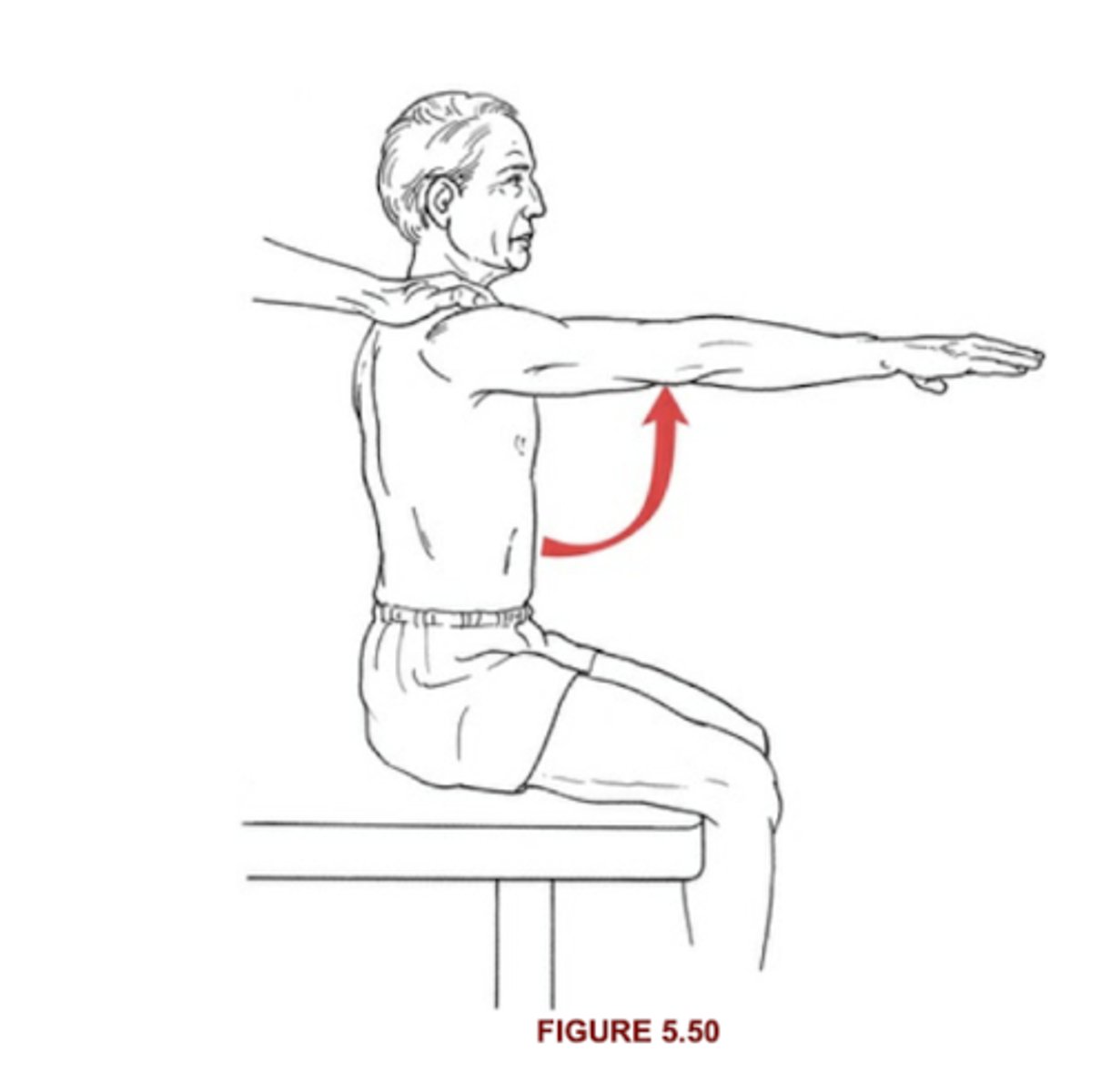
Shoulder flexion 5/5 + 4/5
5: Holds against maximal resistance
4: Holds against moderate resistance
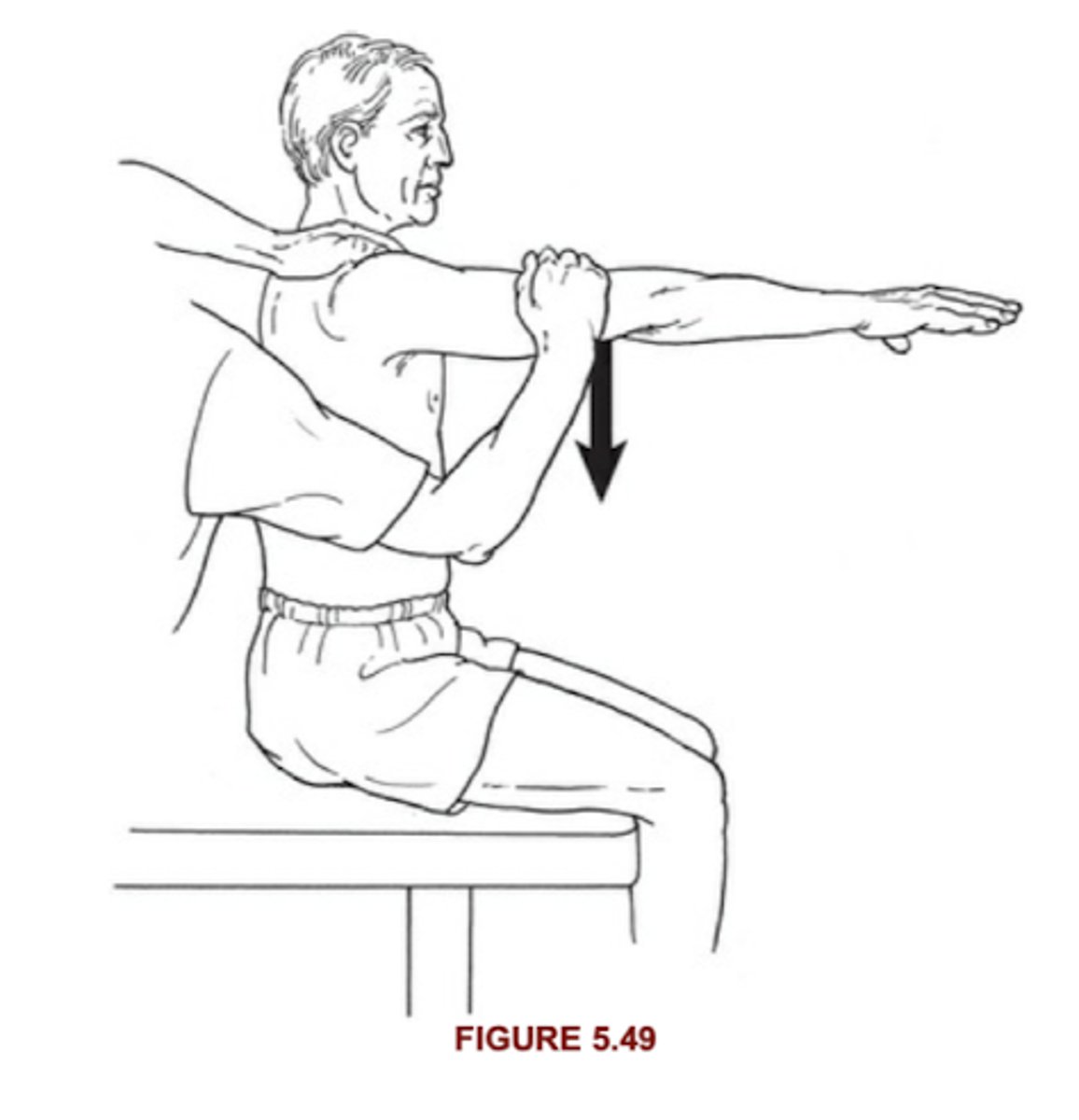
Shoulder flexion 2/5 + 1/5
Sidelying, PT behind pt, cradle arm, completes full ROM in gravity minimized position
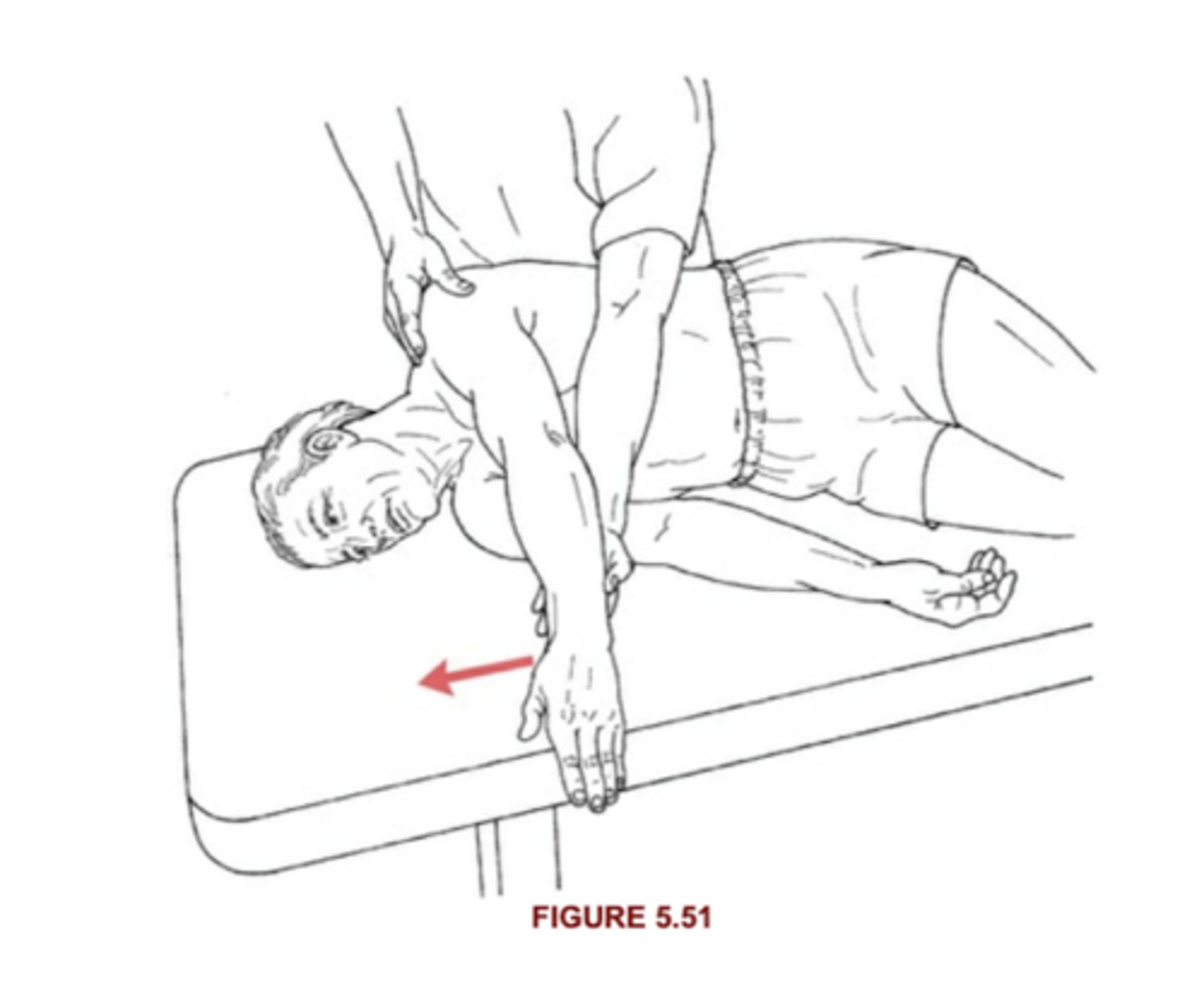
Shoulder flexion 1/5
Therapist feels or sees contractile activity of anterior delt but no motion occurs
Shoulder extension patient position
Prone, arms at side, shoulder IR (palms up)
Shoulder extension PT position
Stand at test side, resist posterior arm of distal brachium, stabilize at other scapula
Shoulder extension muscles tested
1. Posterior deltoid
2. Teres major
3. Latissimus dorsi
Shoulder extension Fair Test (3/5)
Raises arm off table, elbow straight, full available ROM with no resistance
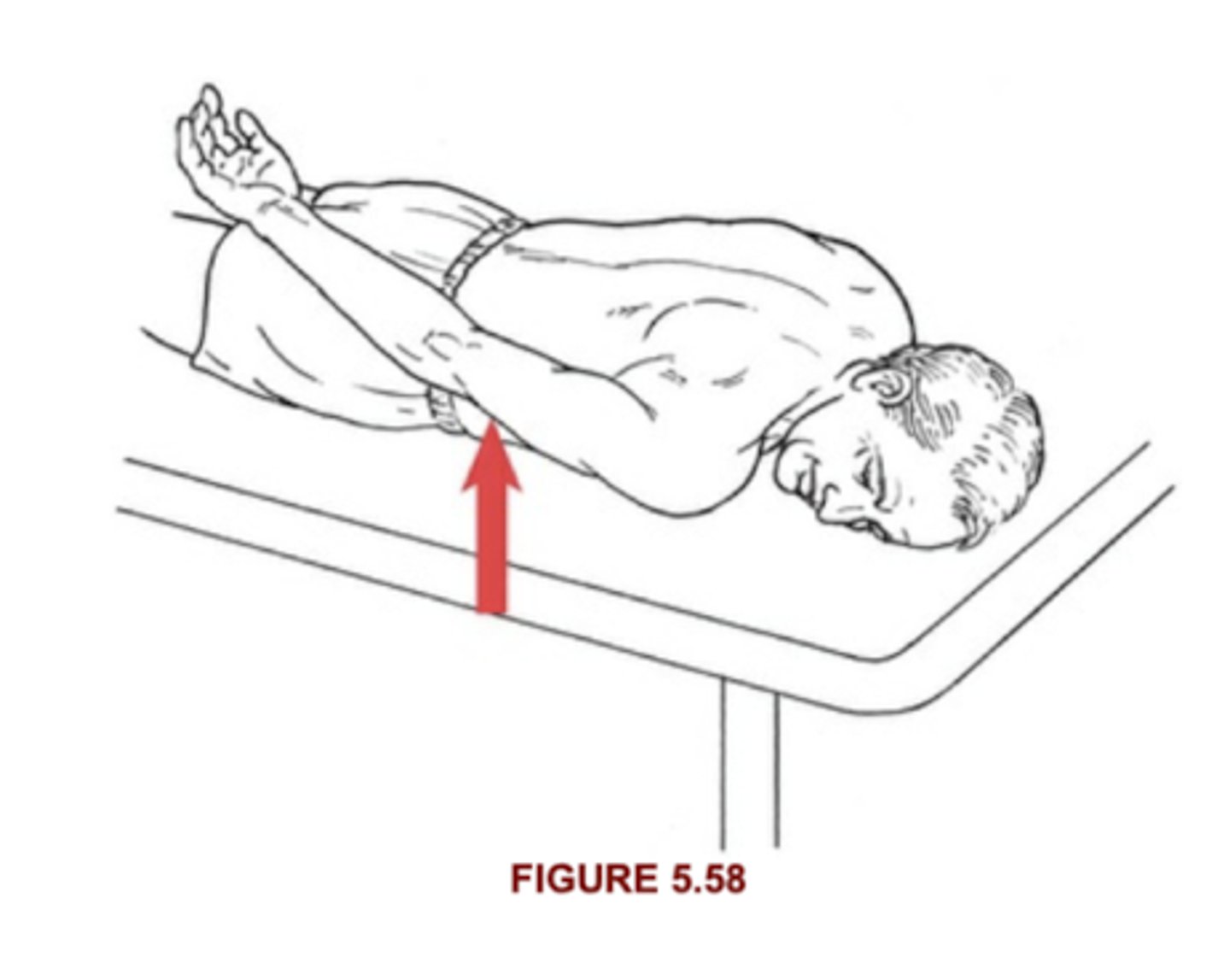
Shoulder extension 5/5 + 4/5
5: Holds position against max resistance
4: Holds against strong resistance
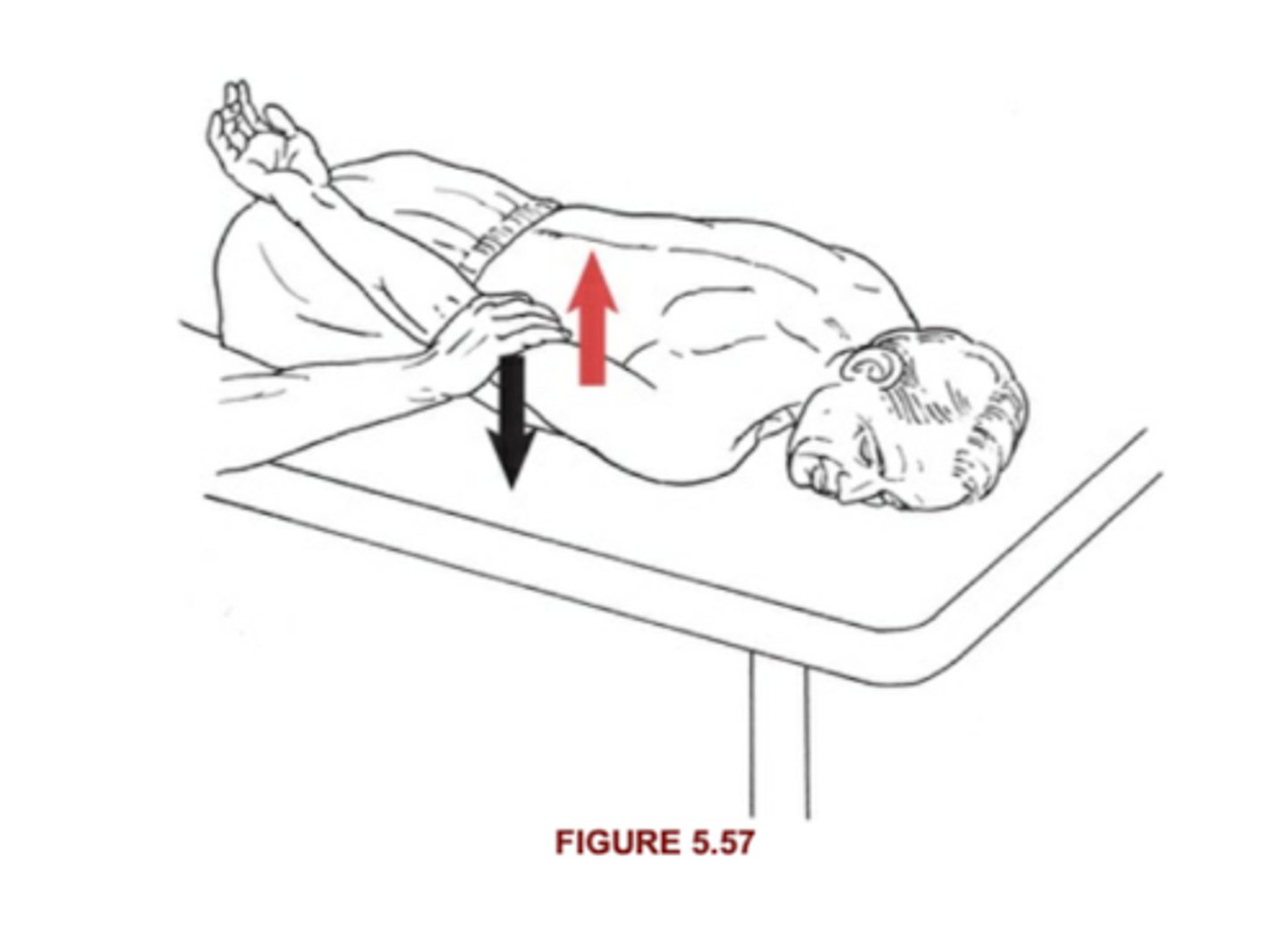
Shoulder extension 2/5
Completes partial range of motion
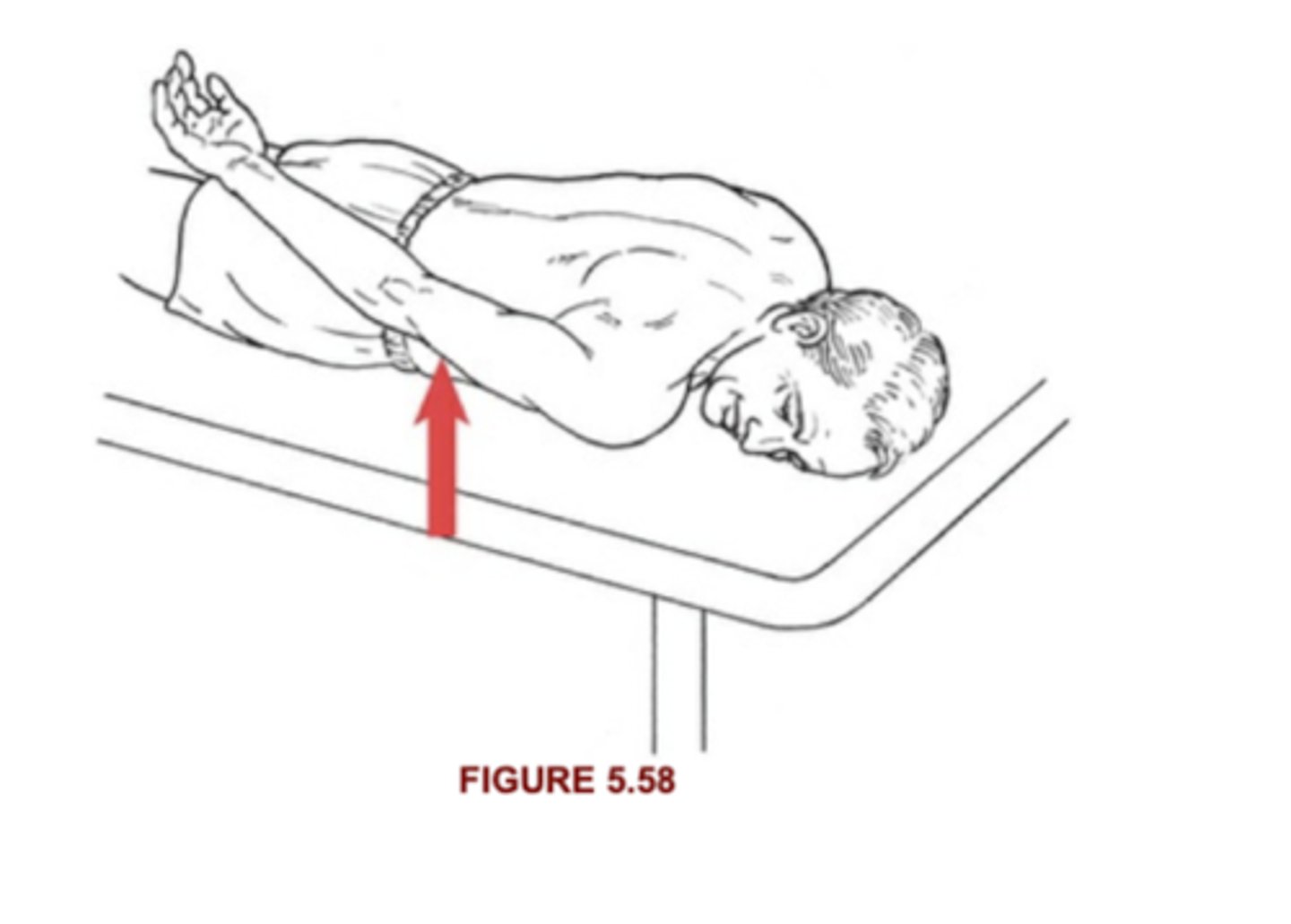
Shoulder extension 1/5
Palpate contractile activity of posterior deltoid, no movement of shoulder
Shoulder abduction patient position
Seated, arm ABD to 90
Shoulder abduction PT position
Behind pt, resist just above elbow, stabilize at test side scapula
Shoulder abduction muscles tested
1. Deltoid
2. Supraspinatus
3. Biceps brachii (long head)
Shoulder abduction Fair Test 3/5
Completes ROM to 90 without resistance
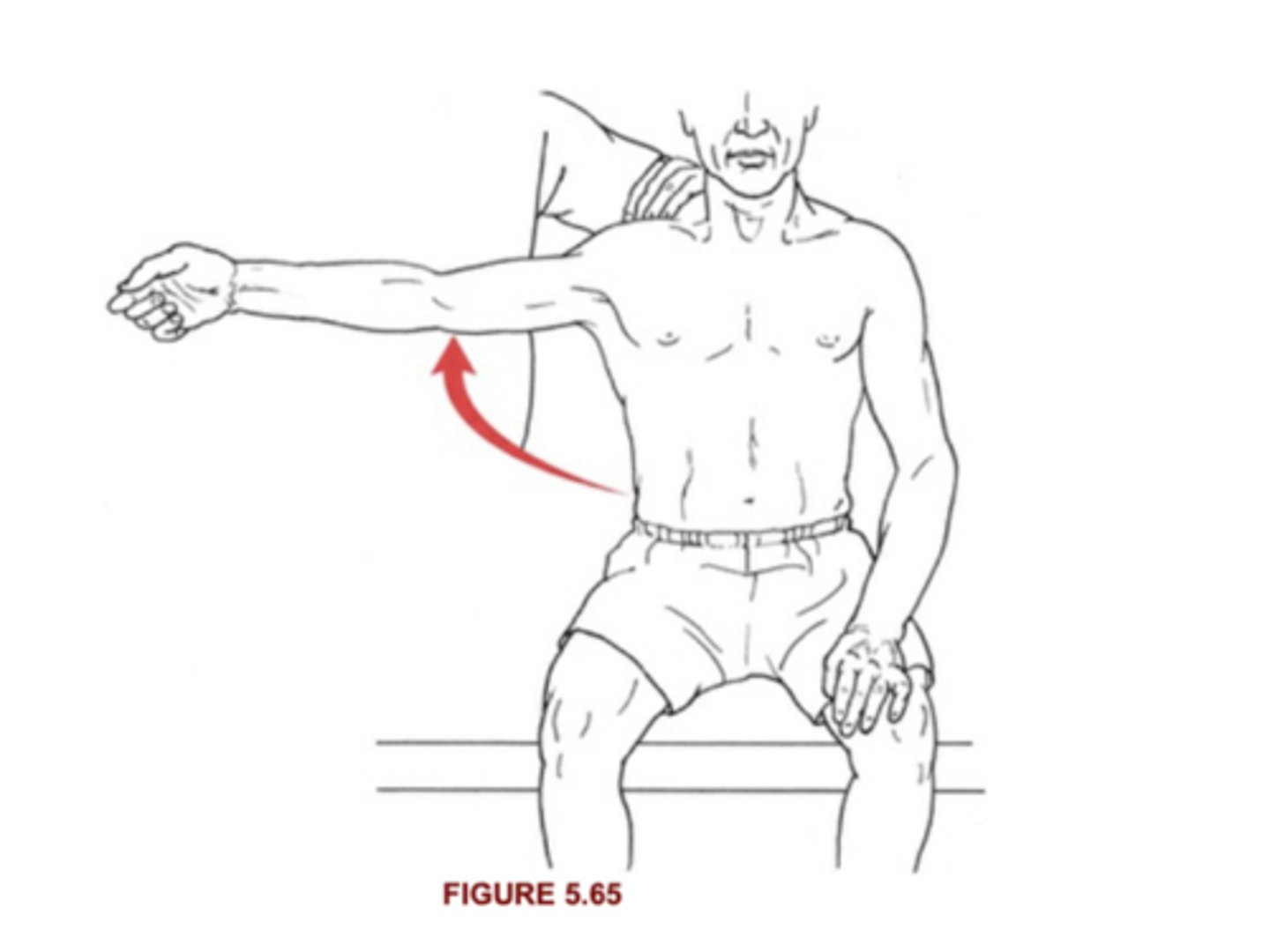
Shoulder abduction 5/5 + 4/5
5: Holds test position against maximal resistance
4: Holds test position against strong resistance
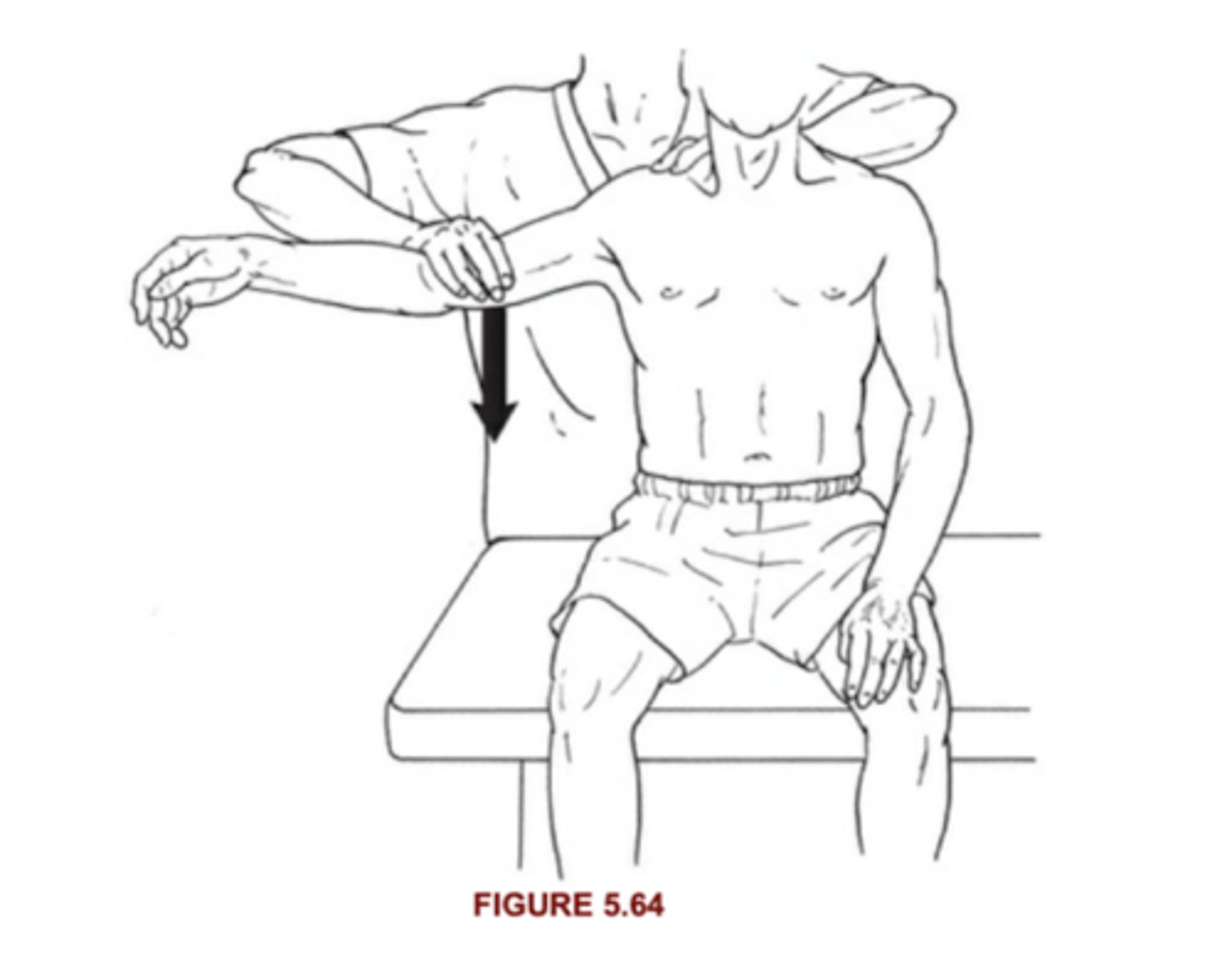
Shoulder abduction 2/5
Supine, arm at side supported on table, thumb pointed outward, completes full ROM in gravity minimized
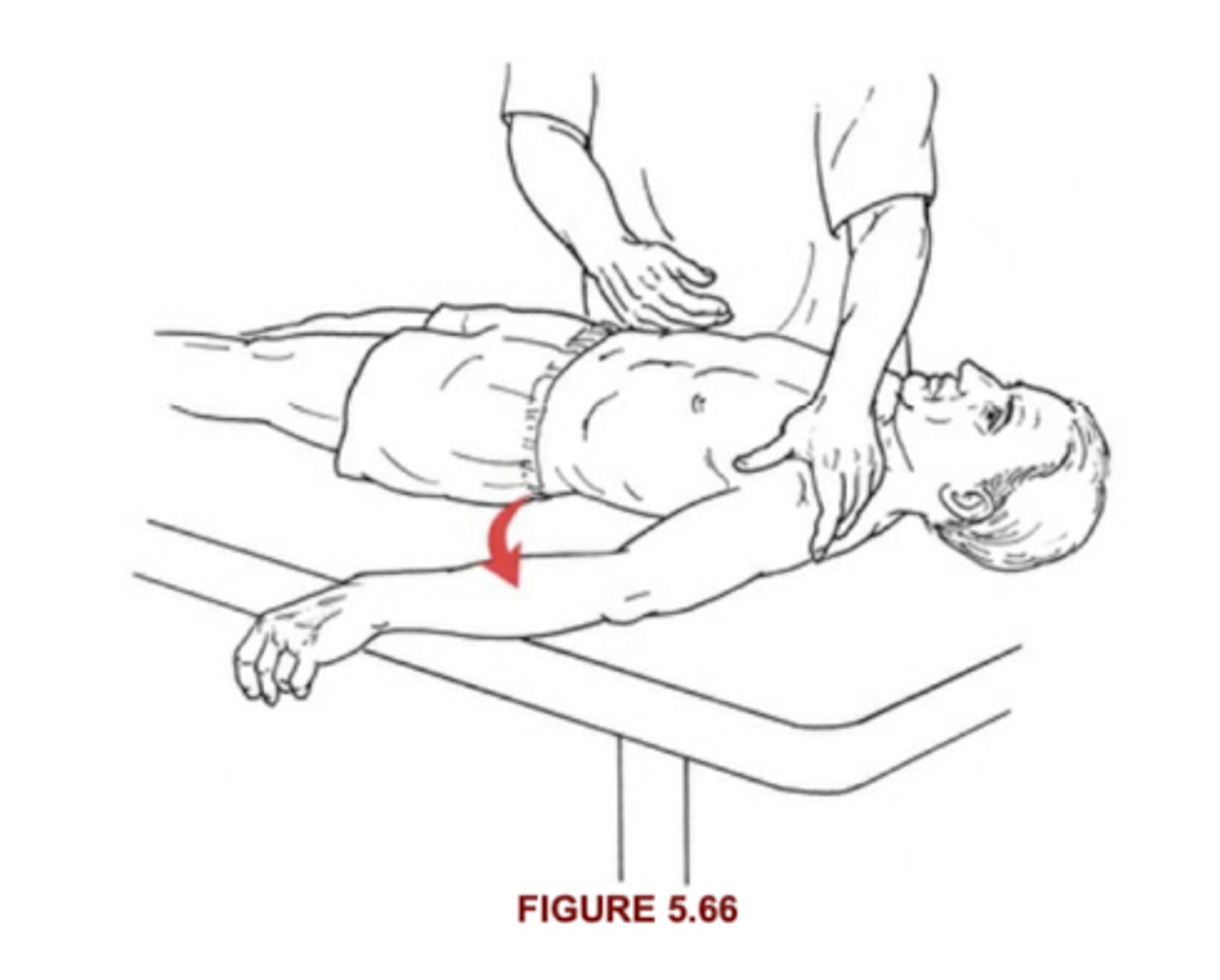
Shoulder abduction 1/5
Palpable or visible contraction of deltoid with no movement
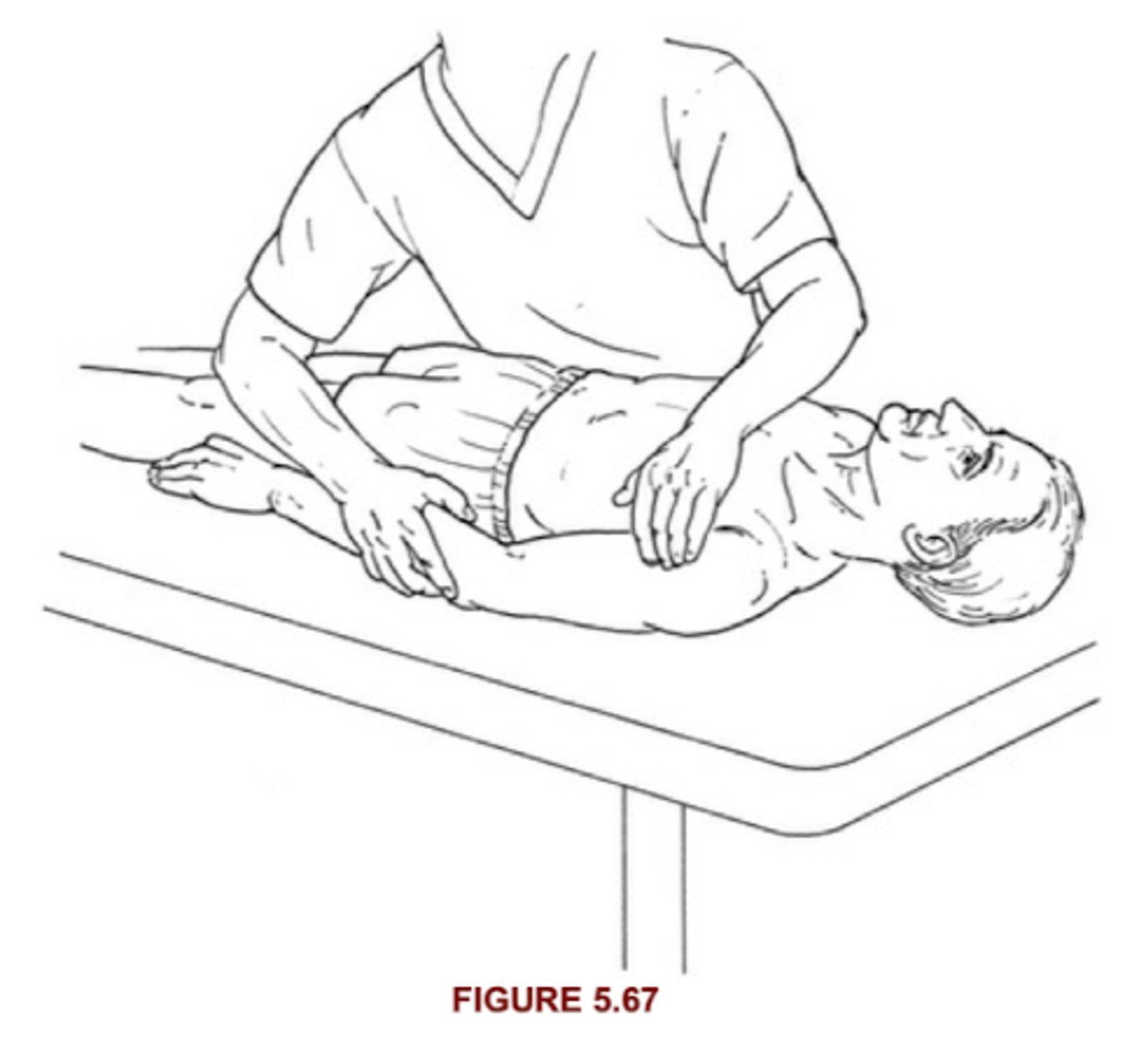
Shoulder horizontal abduction patient position
Prone, shoulder ABD to 90 with forearm hanging off edge, elbow extended
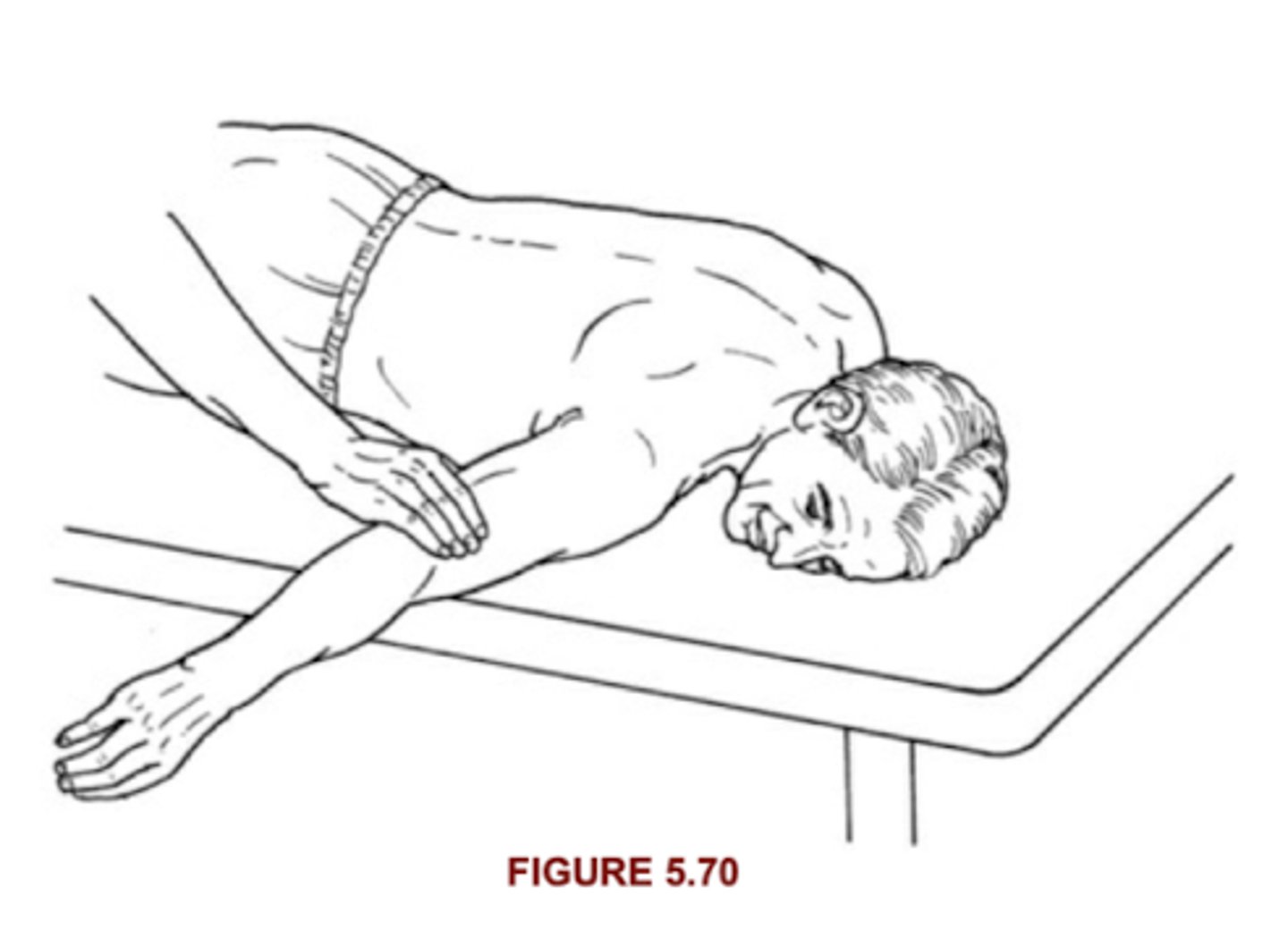
Shoulder horizontal abduction PT position
Behind pt, resist just above elbow, stabilize other scapula
Shoulder horizontal abduction muscles tested
Posterior deltodi
Shoulder horizontal abduction Fair Test 3/5
Completes ROM without resistance, elbow can also be flexed
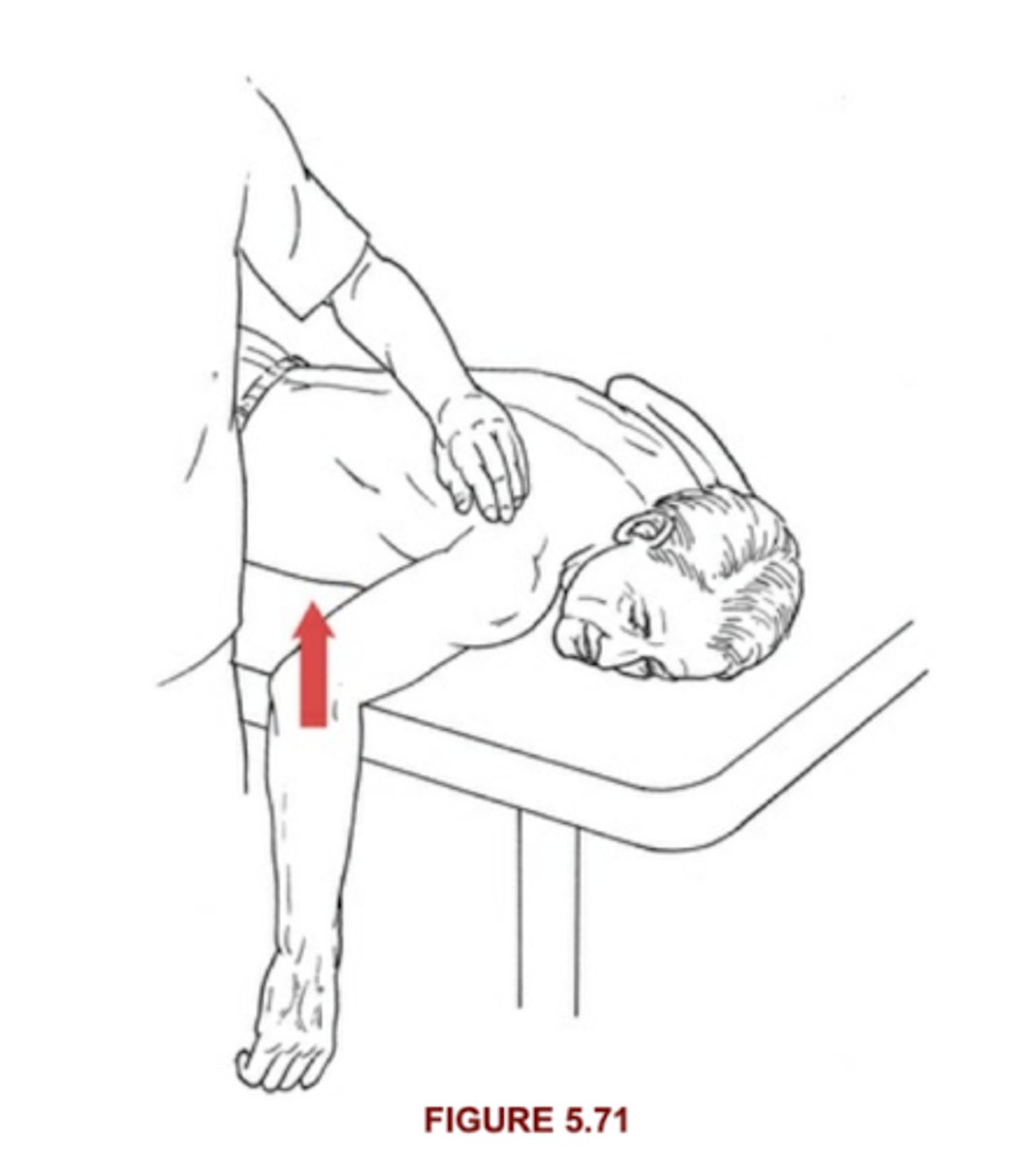
Shoulder horizontal abduction 5/5 + 4/5
5: Holds test position against maximal resistance
4: Holds test position against moderate resistance
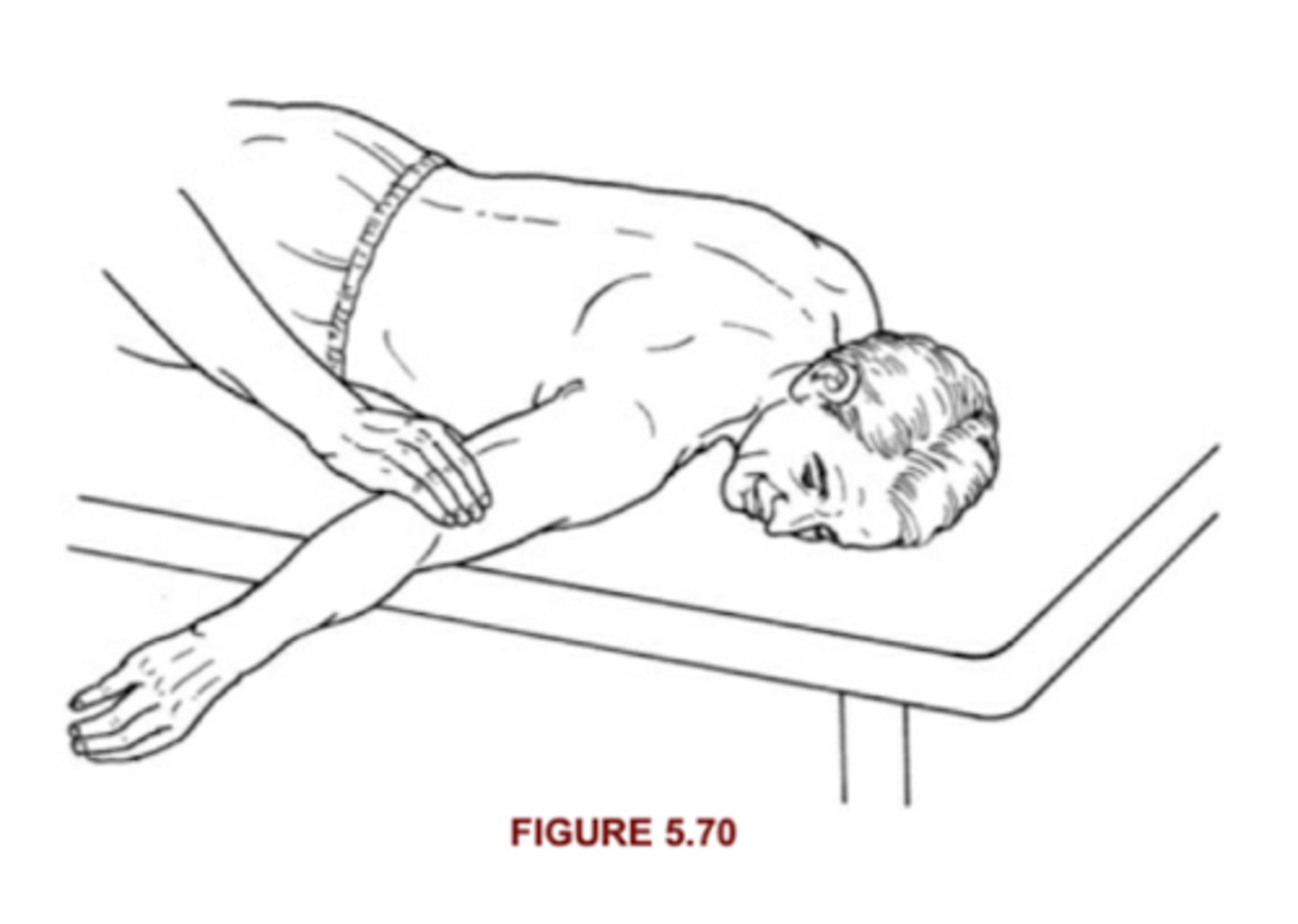
Shoulder horizontal abduction 2/5
Short sitting, shoulder ABD to 90, then horizontal ABD. Full ROM in gravity minimized
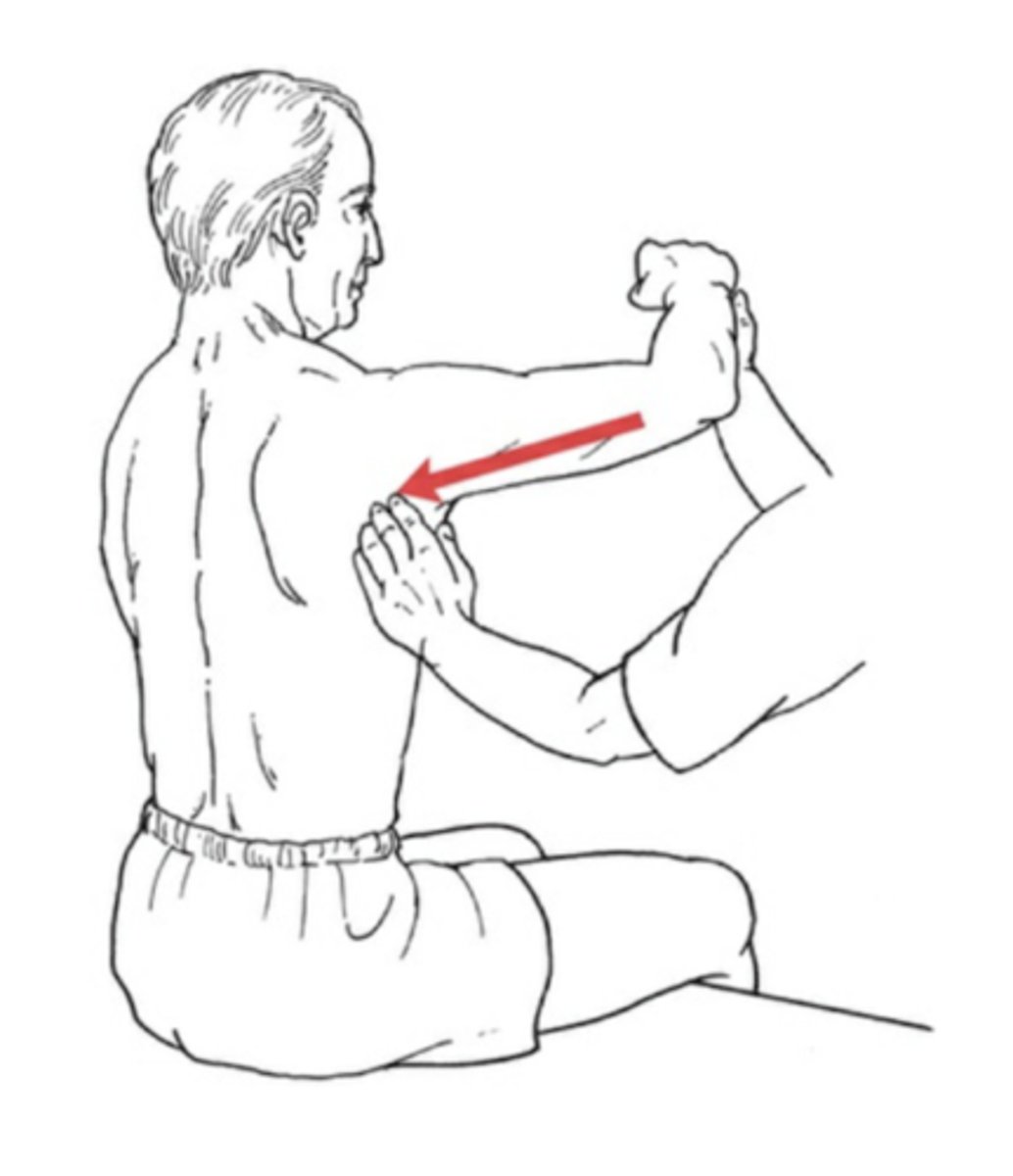
Shoulder horizontal abduction 1/5
Palpate posterior deltoid lateral to spine of scapula
Shoulder horizontal adduction patient position
Supine, elbow flex to 90, shoulder ABD across forehead, straight across, down to pocket
Shoulder horizontal adduction PT position
Resist under distal brachium, just proximal to elbow
Shoulder horizontal adduction muscles tested
Pectoralis major
Shoulder horizontal adduction patient cue (both heads)
"Move your arm across your chest. Hold it. Don't let me pull it back"
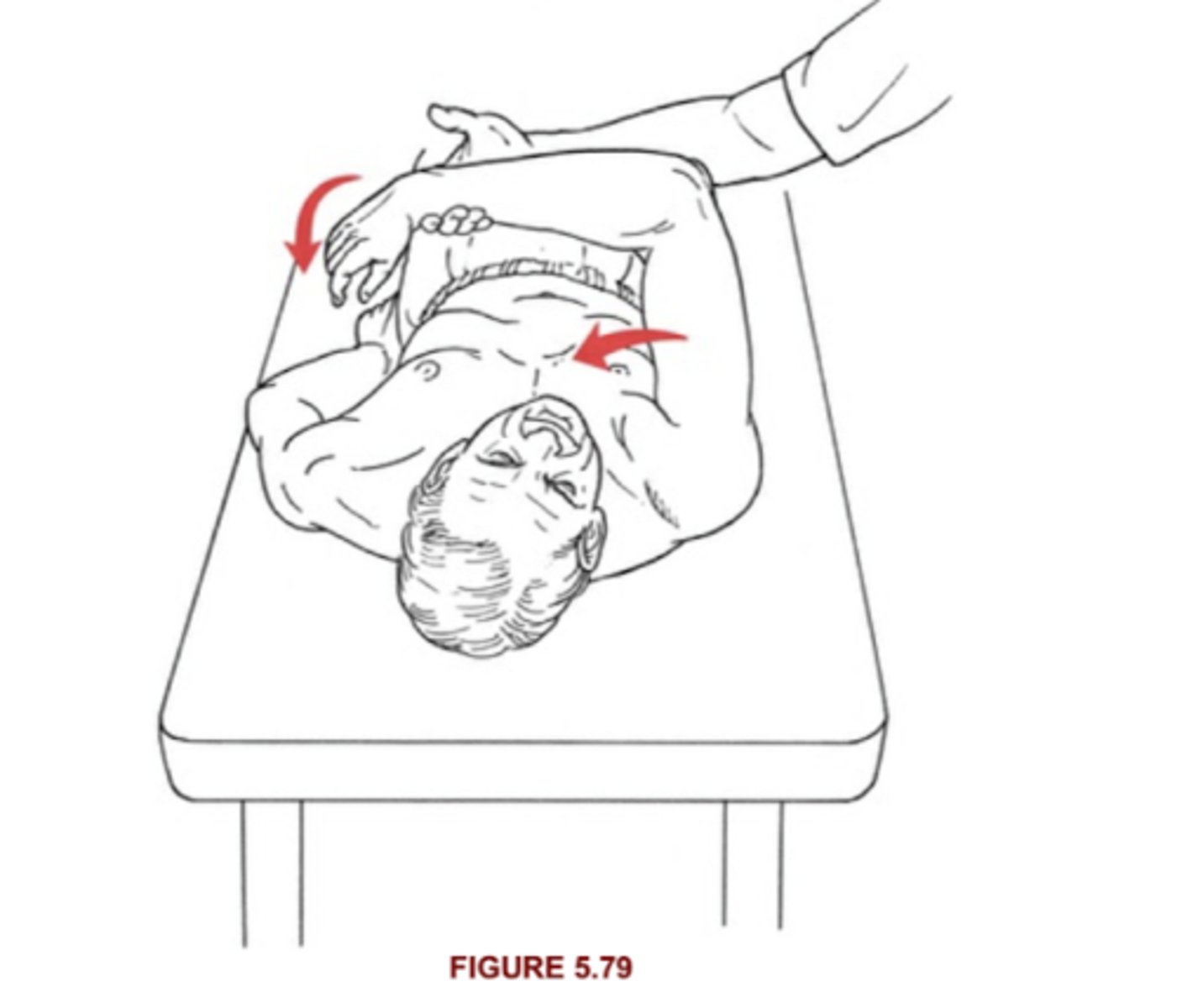
Shoulder horizontal adduction patient cue (clavicular head)
"Move you arm up and in"
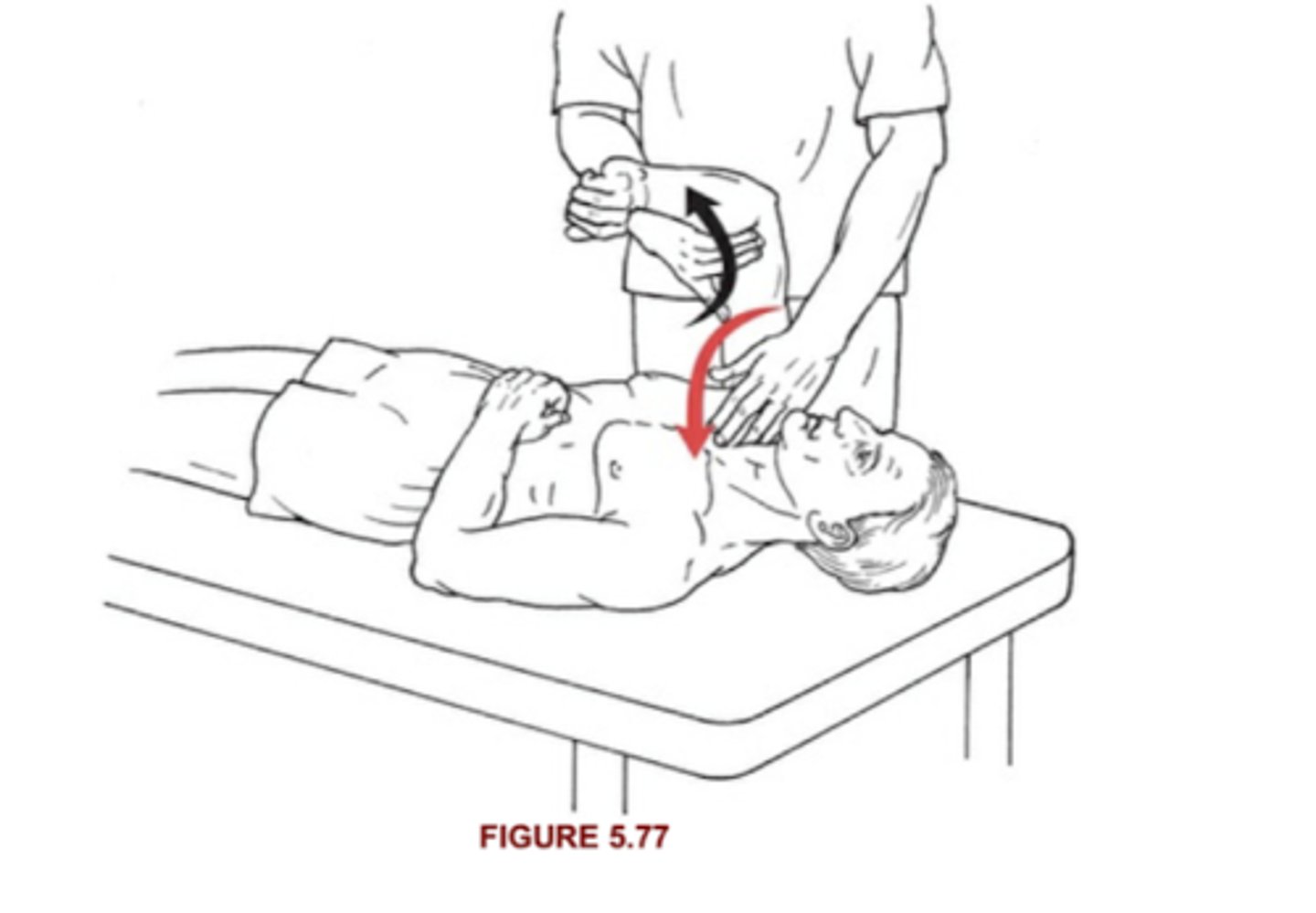
Shoulder horizontal adduction patient cue (sternal head)
"Move your arm down and in"
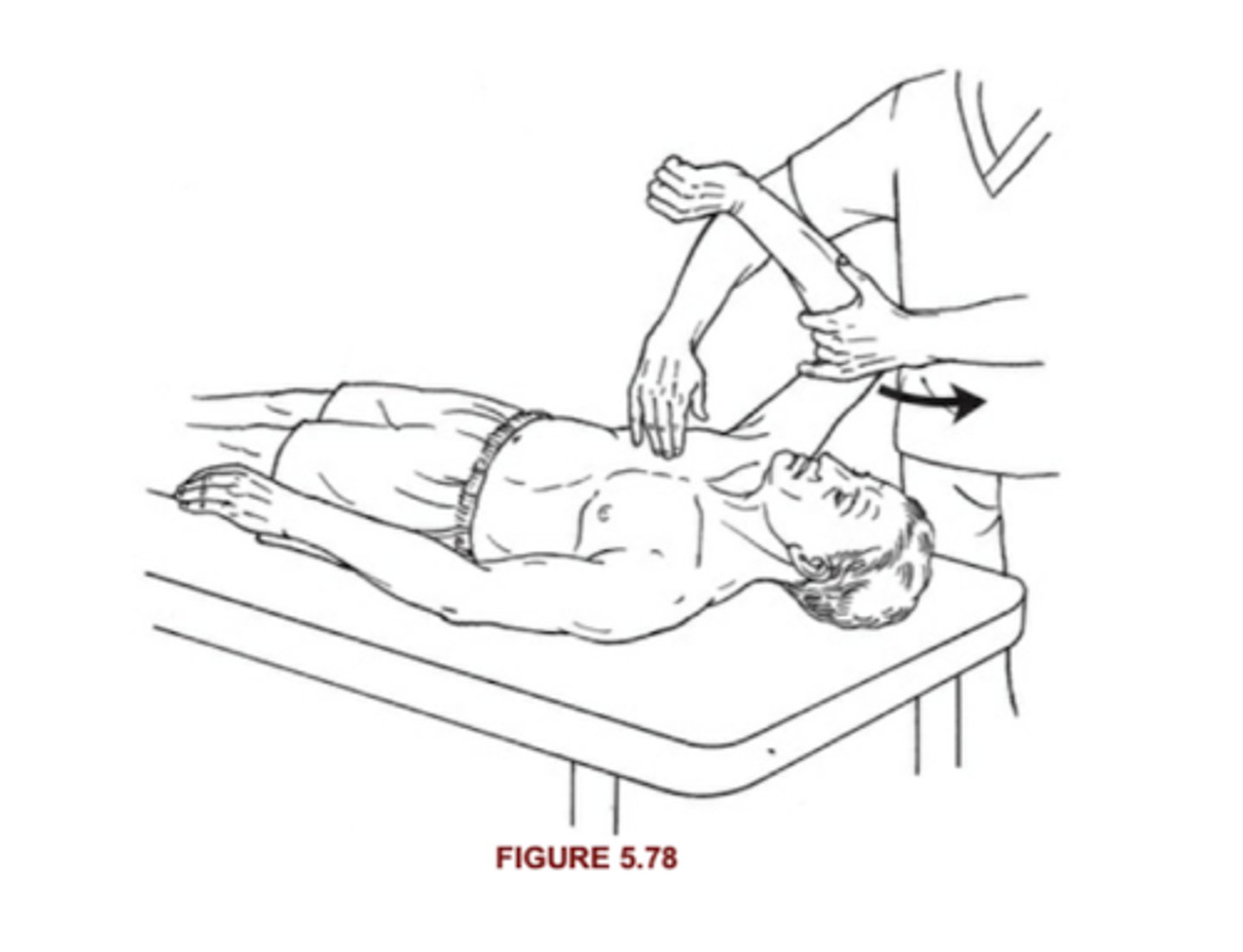
Shoulder horizontal adduction Fair Test 3/5
Completes available range of motion in all three tests, with no resistance
Shoulder horizontal adduction 5/5 + 4/5
5: Holds against maximal resistance (specific head)
4: Holds against strong to moderate resistance, but muscle exhibits some "give" at end of range (specific head)
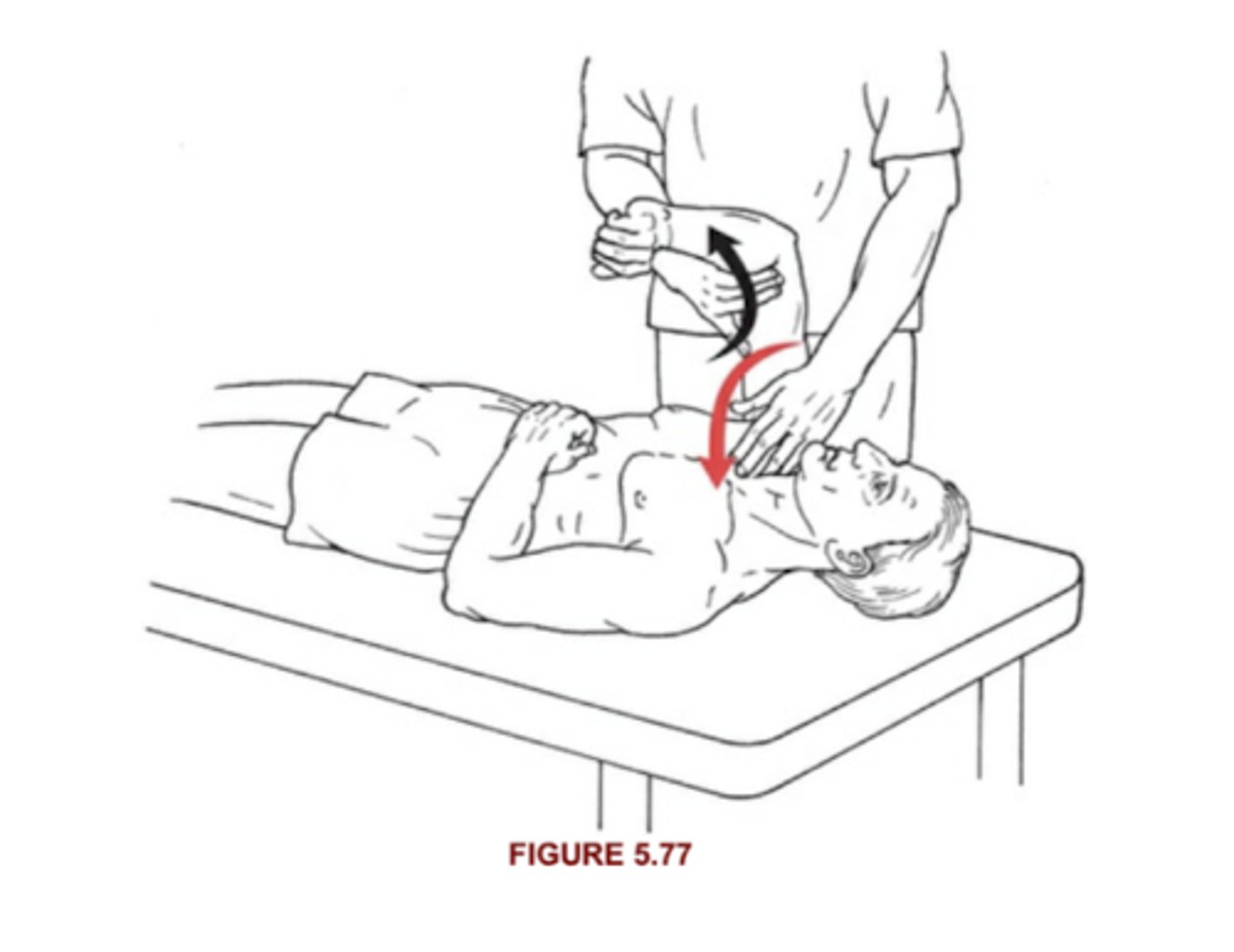
Shoulder horizontal adduction 2/5
Seated with arm supported on table, ABD to 90. Full ROM in PT supported position
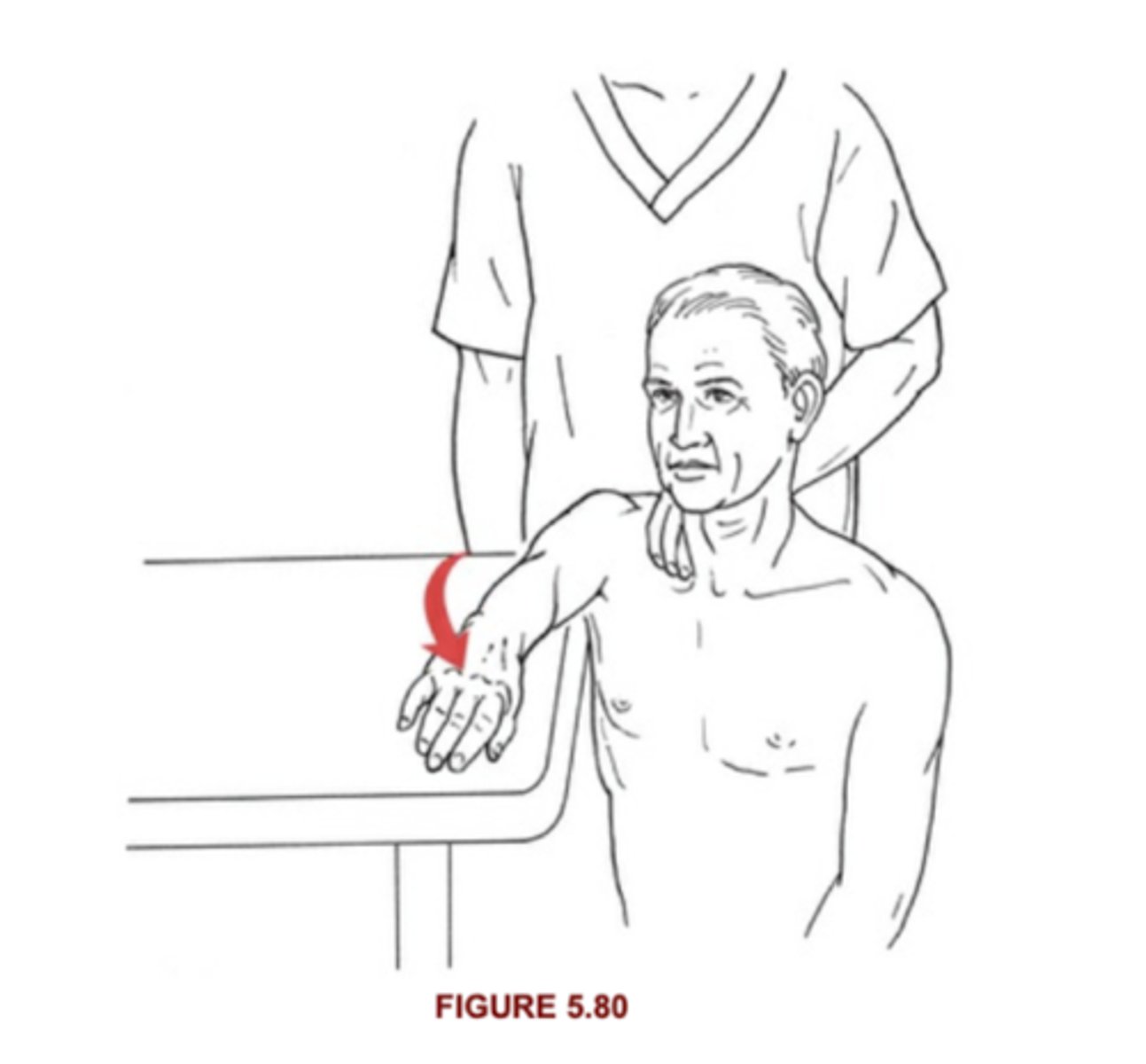
Shoulder horizontal adduction 1/5
Palpable contractile activity of pec major
Shoulder IR patient position
Prone, head toward test side, shoulder ABD to 90, forearm hanging off table
Shoulder IR PT position
Resist volar side of forearm, just above wrist
Shoulder IR muscles tested
1. Subscapularis
2. Teres major
3. Pectoralis major
4. Latissimus dorsi
Shoulder IR patient cue
"Move your forearm up and back. Hold it, don't ket me push it down"
Shoulder IR Fair Test 3/5
Completes full ROM with no resistance
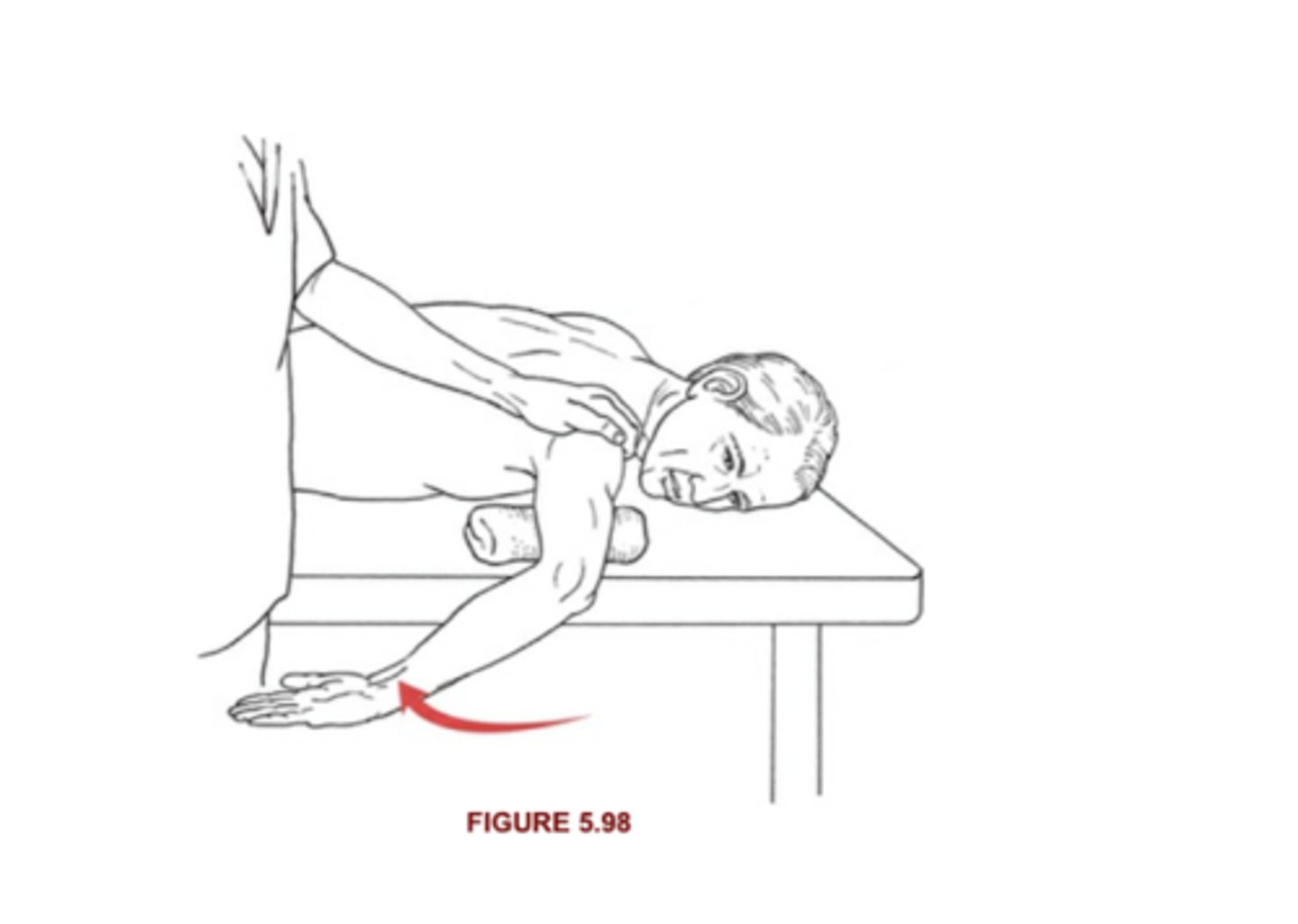
Shoulder IR 5/5 + 4/5
5: Holds against strong resistance
4: Holds but there is some give against strong resistance
Shoulder IR 2/5
Seated with weight supported by PT or table, not able to complete available range
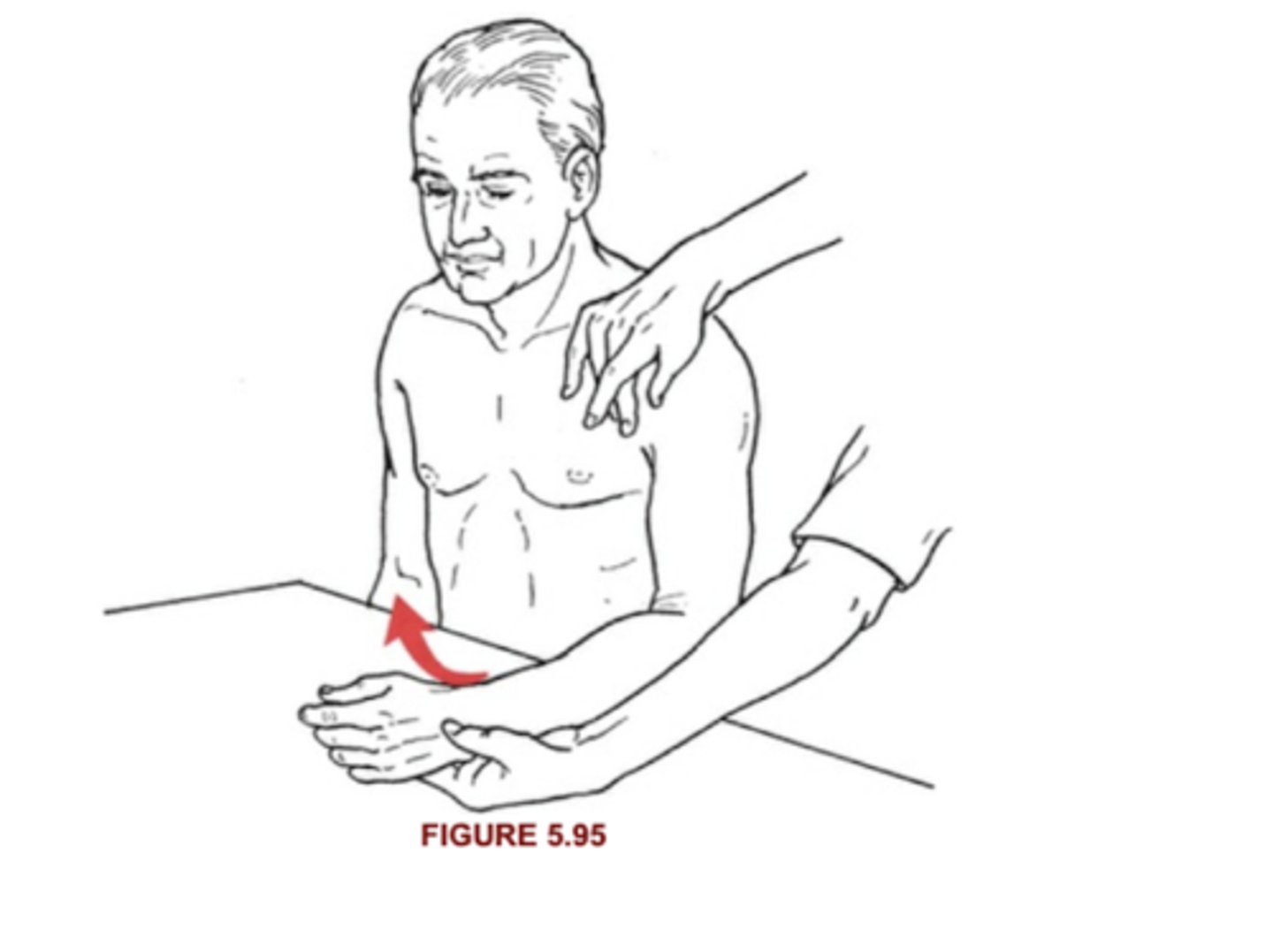
Shoulder IR 1/5
Palpable contraction occurs at pec major
Shoulder ER patient position
Prone, head toward test side, shoulder ABD to 90, forearm hanging off table
Shoulder ER PT position
Stabilize medial aspect of elbow and resist at dorsal surface of forearm, just proximal to wrist
Shoulder ER muscles tested
1. Infraspinatus
2. Teres minor
Shoulder ER patient cue
"Raise your arm to the level of the table, hold it, don't let me push it down"
Shoulder ER Fair Test 3/5
Completes available ROM without resistance
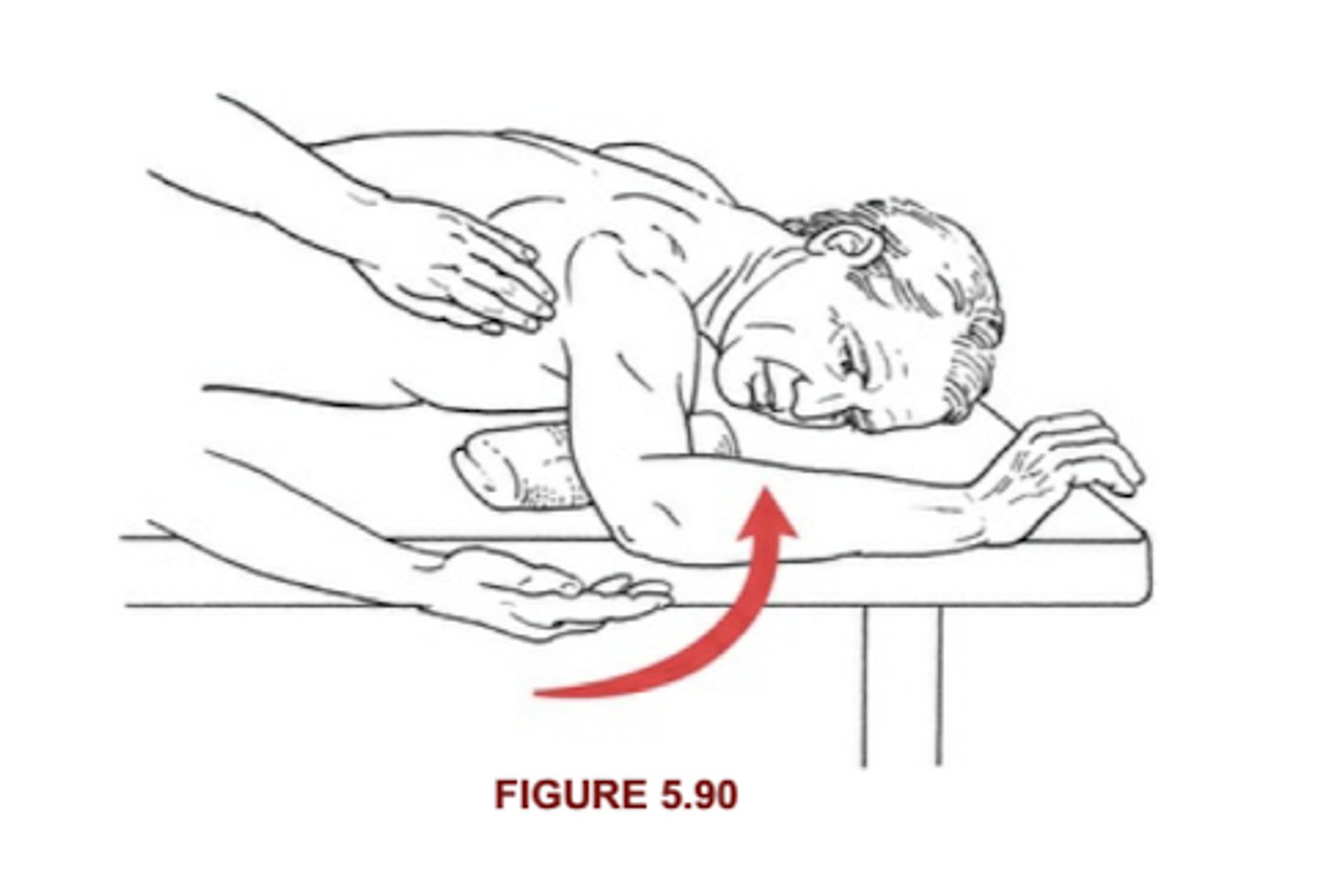
Shoulder ER 5/5 + 4/5
Holds against strong resistance
4: Holds, but end range gives way with strong resistance
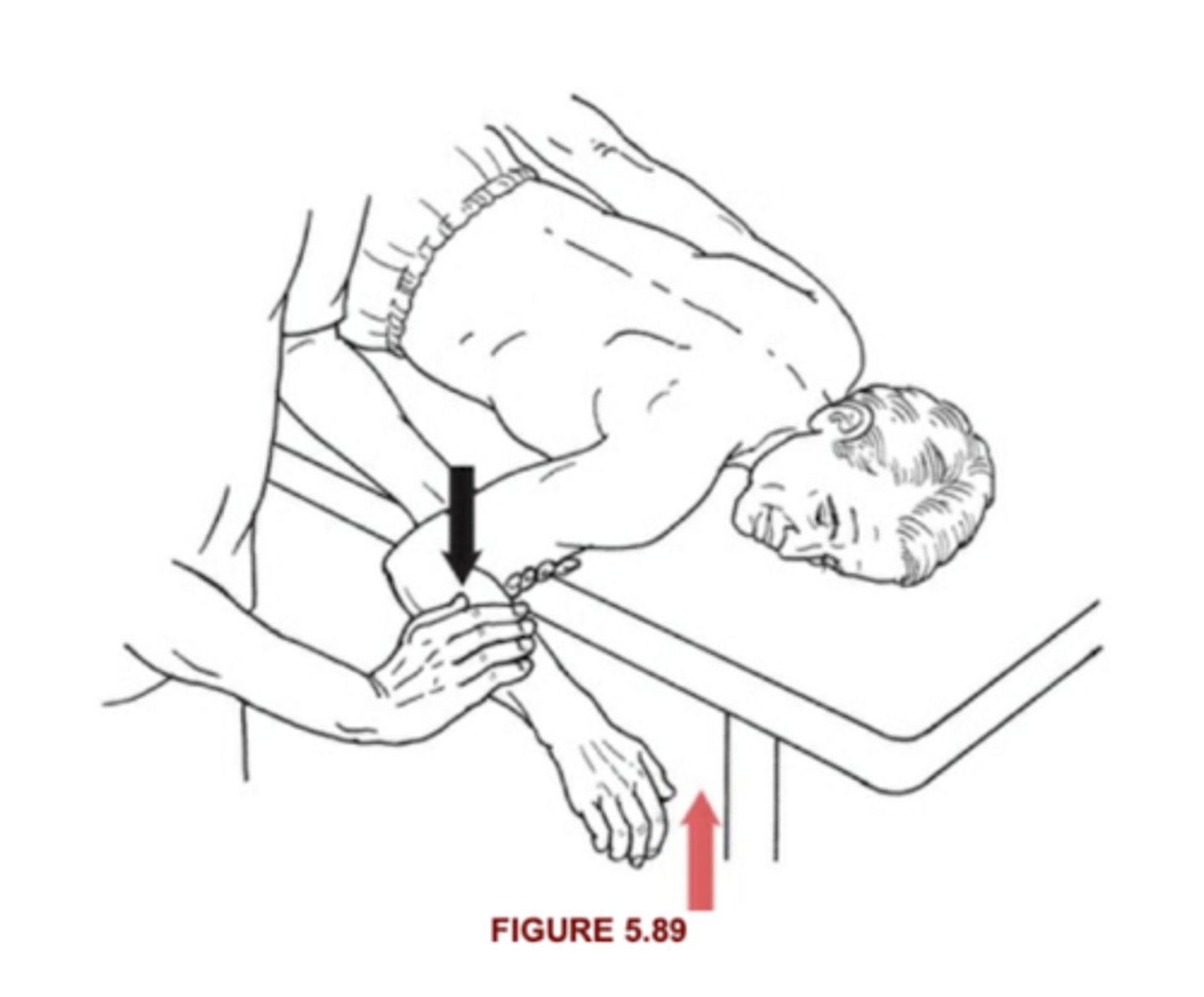
Shoulder ER 2/5
Seated with weight supported, Completes ROM in gravity eliminated
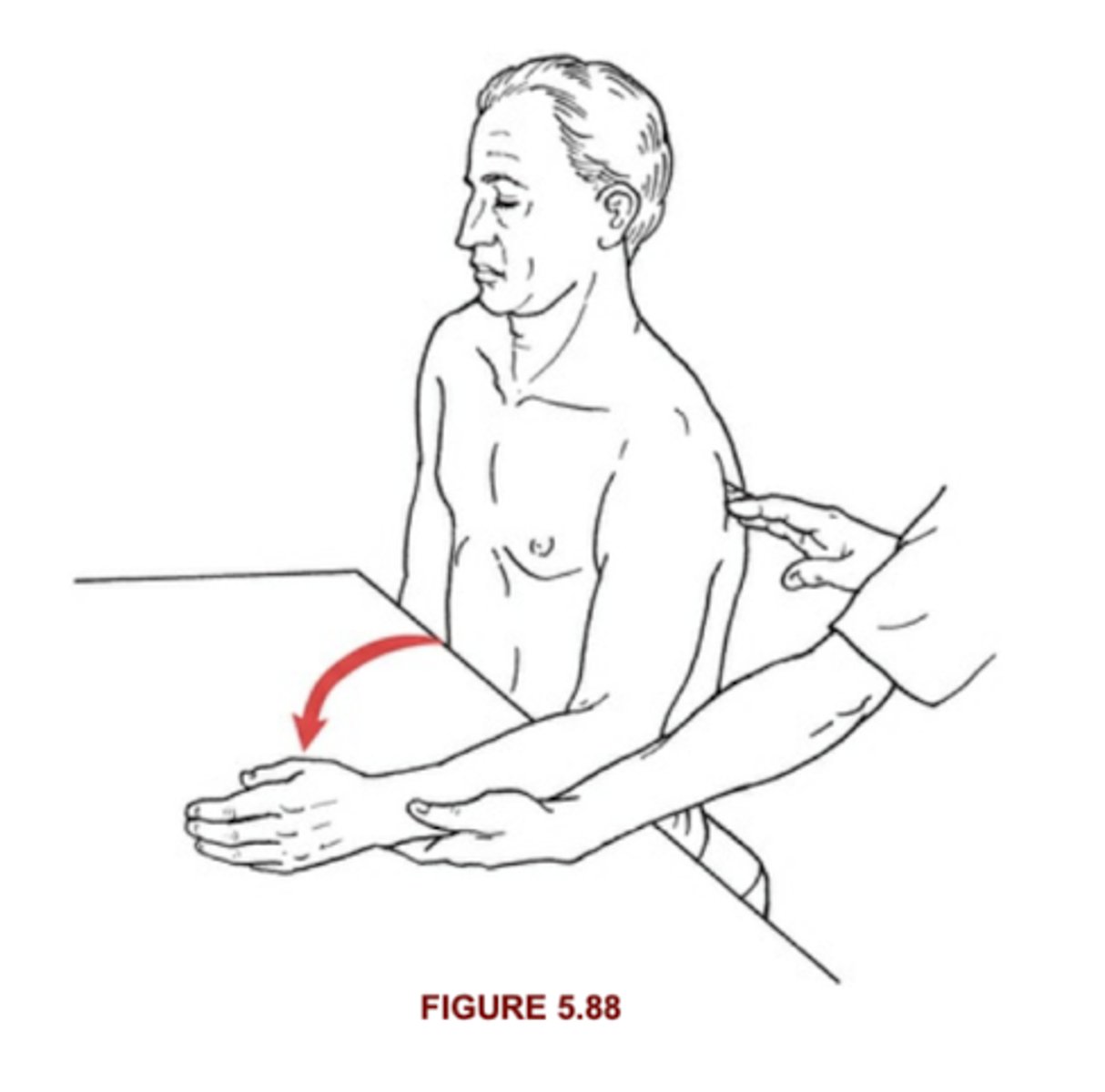
Shoulder ER 1/5
Palpate infraspinatus for contractile activity
Scapular ABD w/ upward rotation patient position
Seated with arm flexed to 130, protracted in that plane as far as it can move
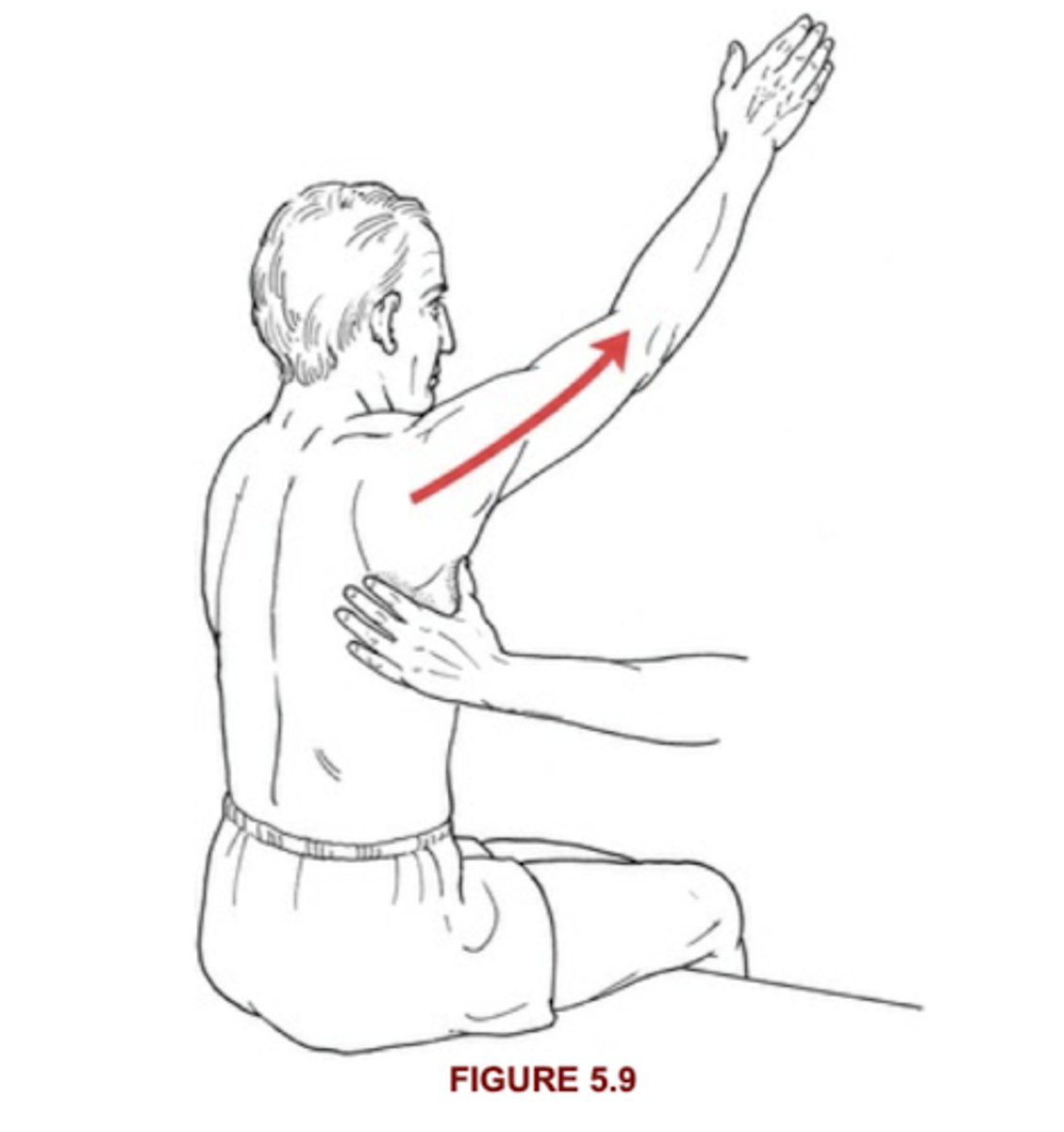
Scapular ABD w/ upward rotation PT position
Resist at upper arm, just above elbow, stabilize trunk below scapula on same side
Scapular ABD w/ upward rotation muscles tested
Serratus anterior
Pectoralis minor
Scapular ABD w/ upward rotation Fair Test 3/5
Scapula moves through full ROM, without winging and without resistance
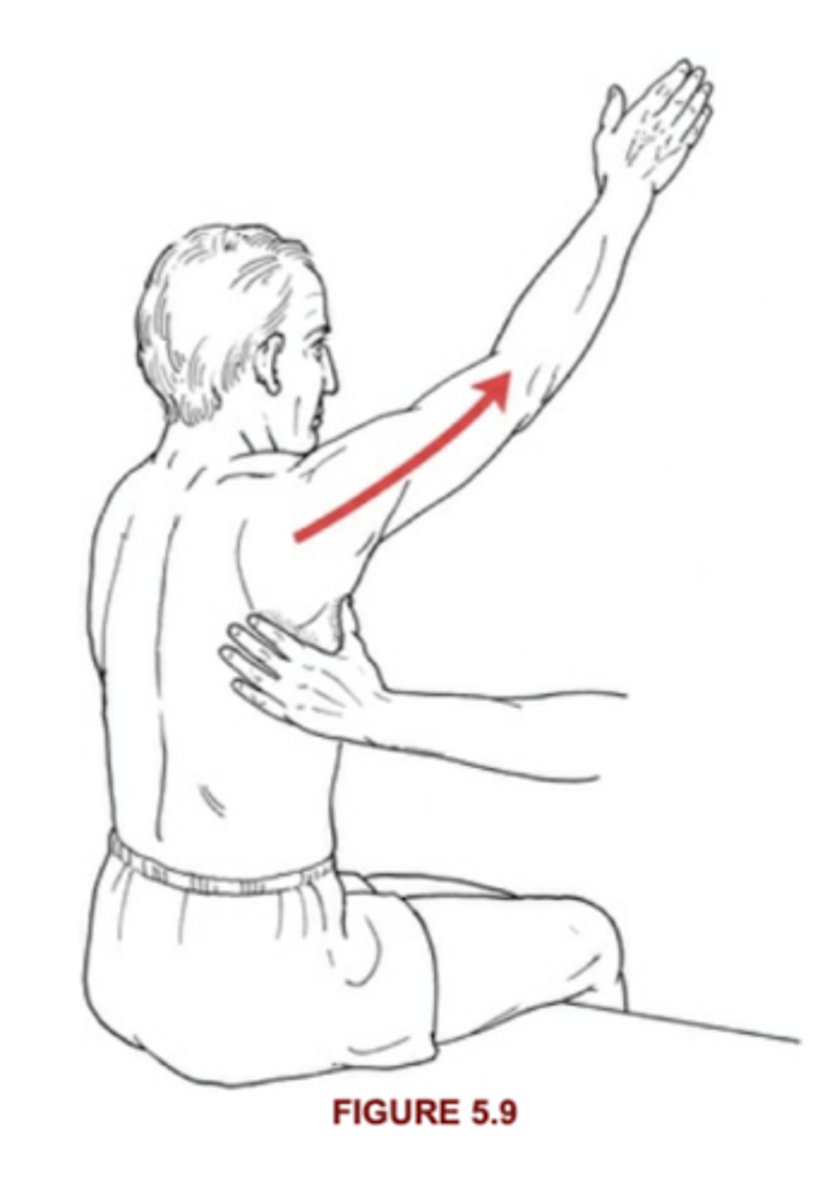
Scapular ABD w/ upward rotation 5/5 + 4/5
5: Scapula stays ABD and rotated against max resistance
4: Scapular muscles "give" against max resistance
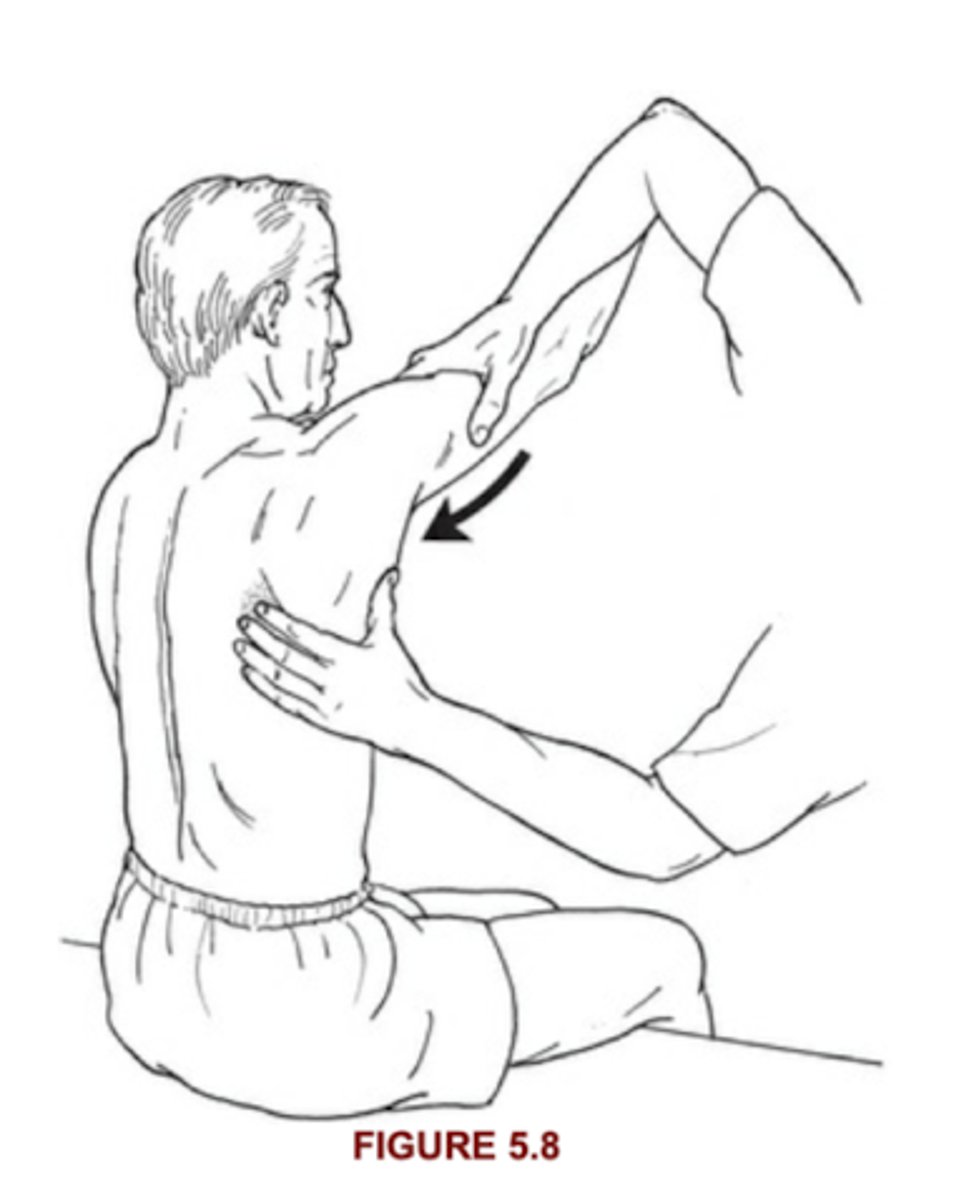
Scapular ABD w/ upward rotation 2/5
Arm flexed to 90, supported by PT, other hand of PT on inferior angle of scapula, no scapular motion
Scapular ABD w/ upward rotation 1/5
Palpate serratus anterior
Scapular elevation patient position
Seated at edge of table, hands in lap, shrug shoulders up
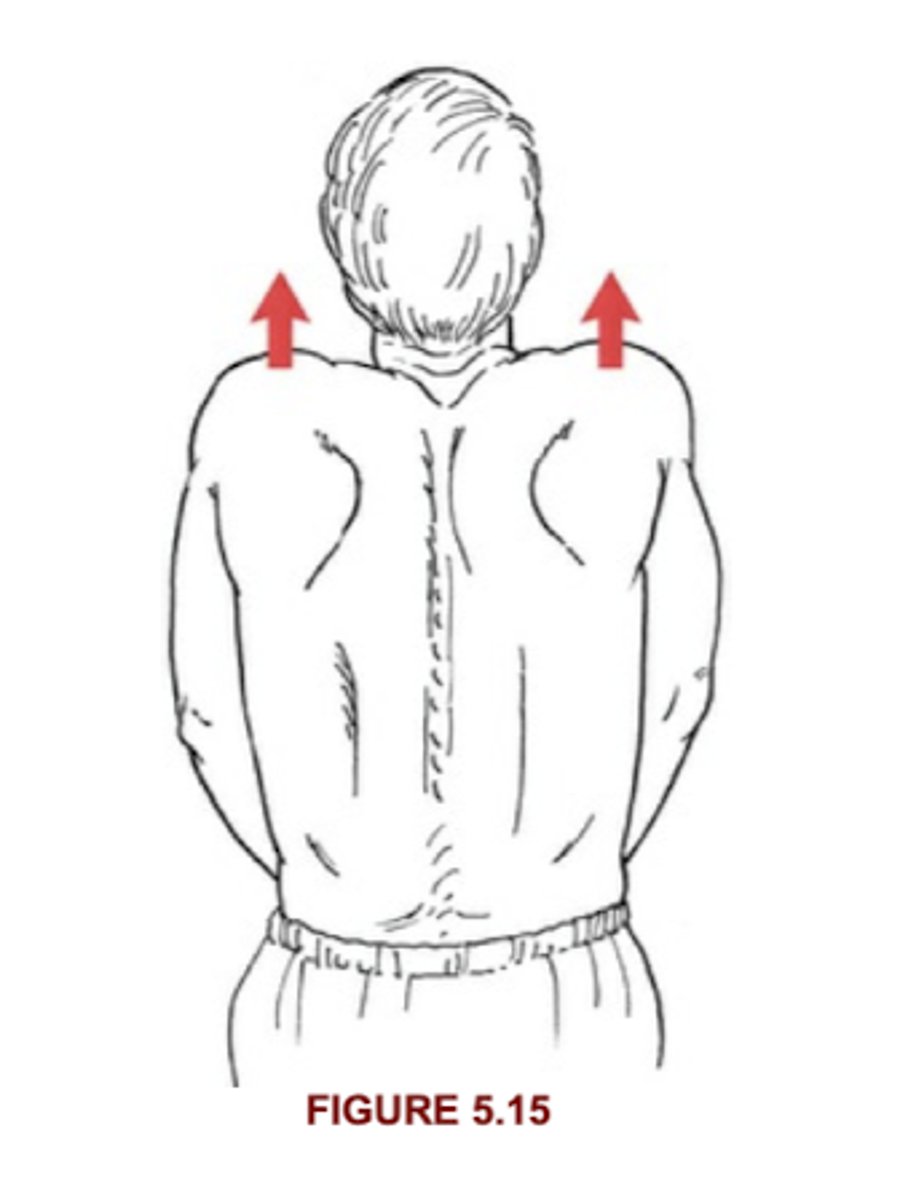
Scapular elevation PT position
Resists from top of shoulders, behind patient
Scapular elevation muscles tested
Upper trapezius
Levator scapulae
Scapular elevation Fair Test 3/5
Elevates thru full ROM, without resistance
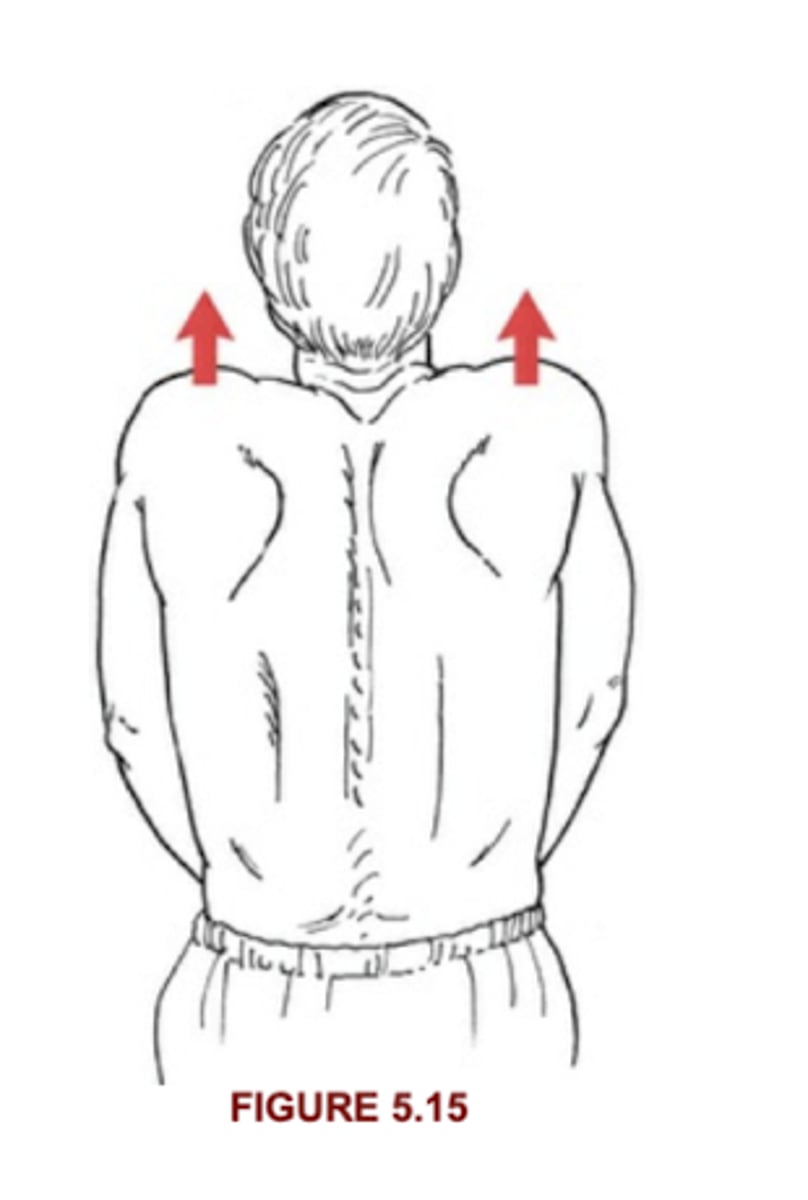
Scapular elevation 5/5 + 4/5
5. Holds against max resistance
4. Holds against strong-moderate resistance
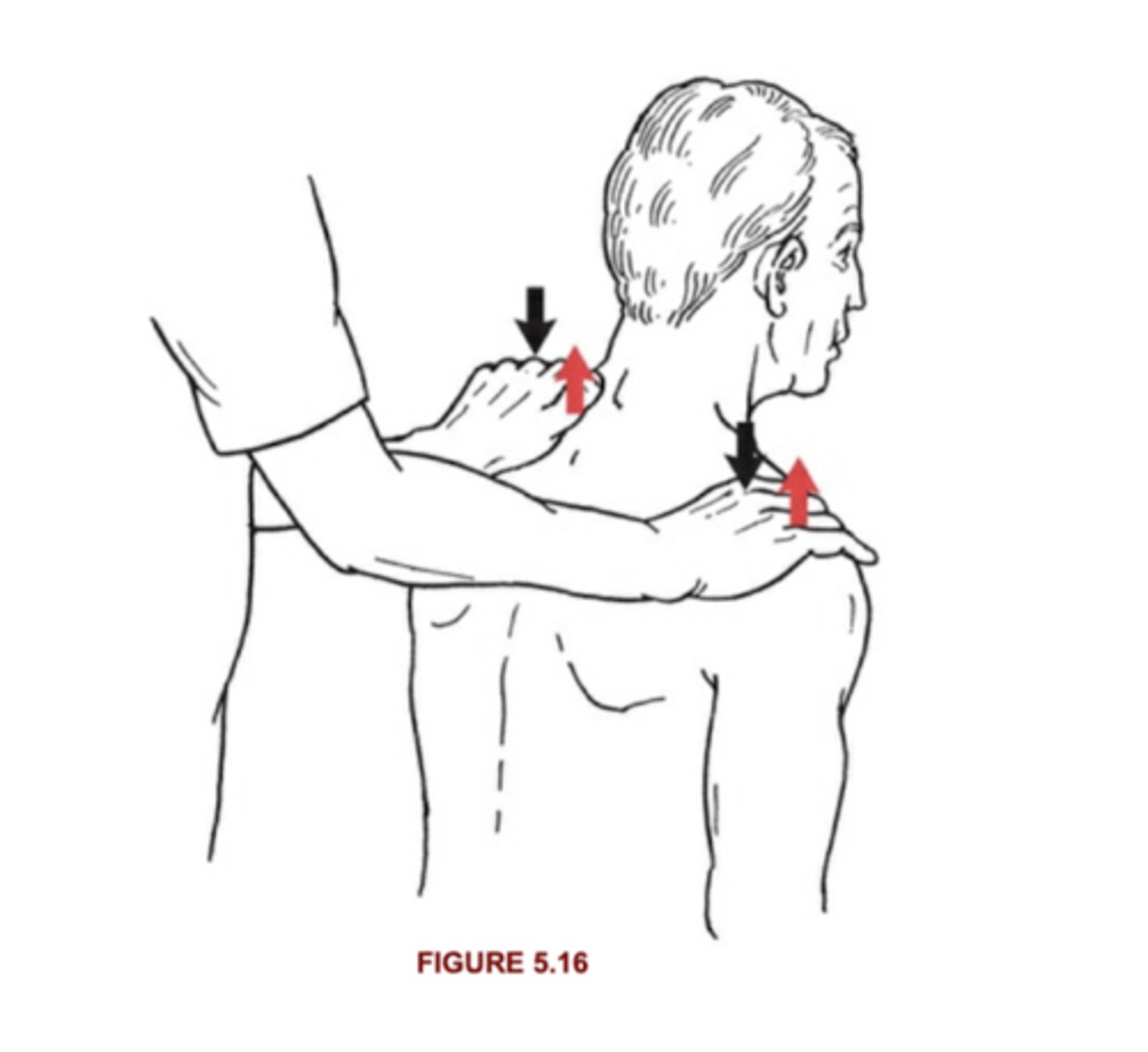
Scapular elevation 2/5
Prone, head turned away from test side, feel upper trap. 2/5 is FULL ROM in this position
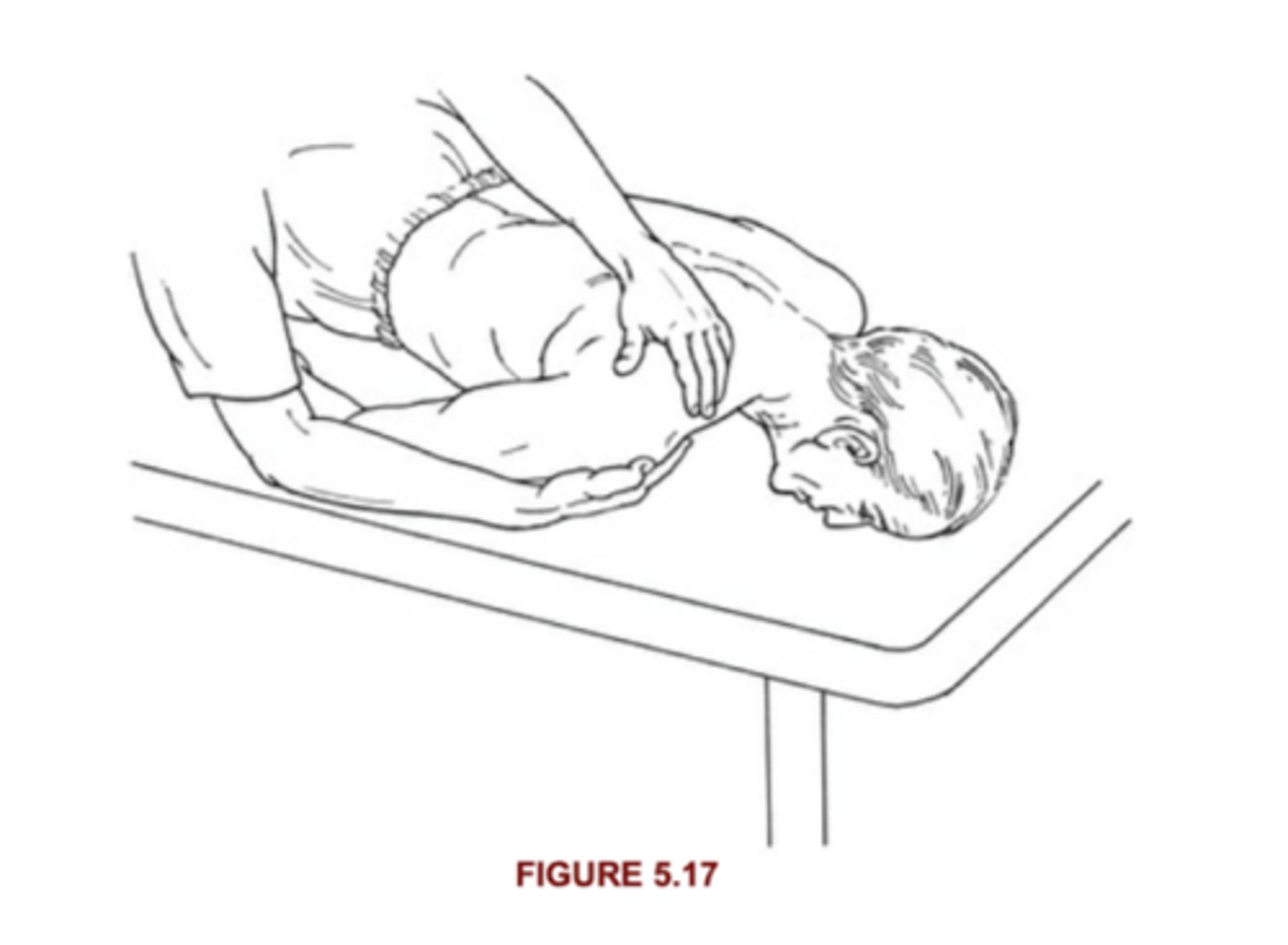
Scapular elevation 1/5
Palpate upper trapezius
Scapular adduction (retraction) patient position
Prone at edge of table, shoulder ABD to 90, elbow flexed to 90, forearm hanging off table
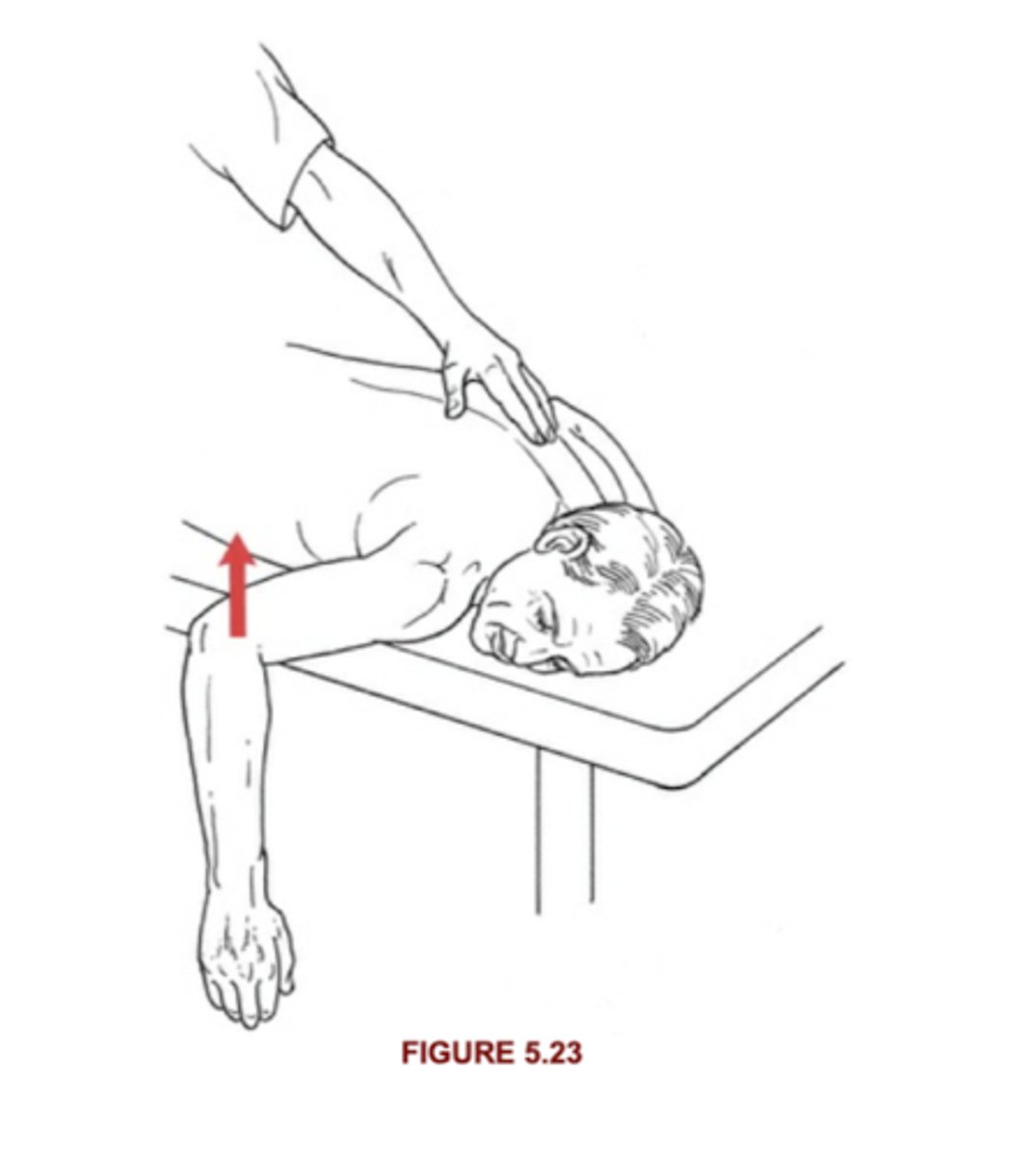
Scapular adduction (retraction) PT position
Stabilize contralateral scapula, resist at shoulder in downward direction
Scapular adduction (retraction) muscles tested
Middle traps Rhomboid major
Scapular adduction (retraction) Fair Test 3/5
Completes available range without resistance
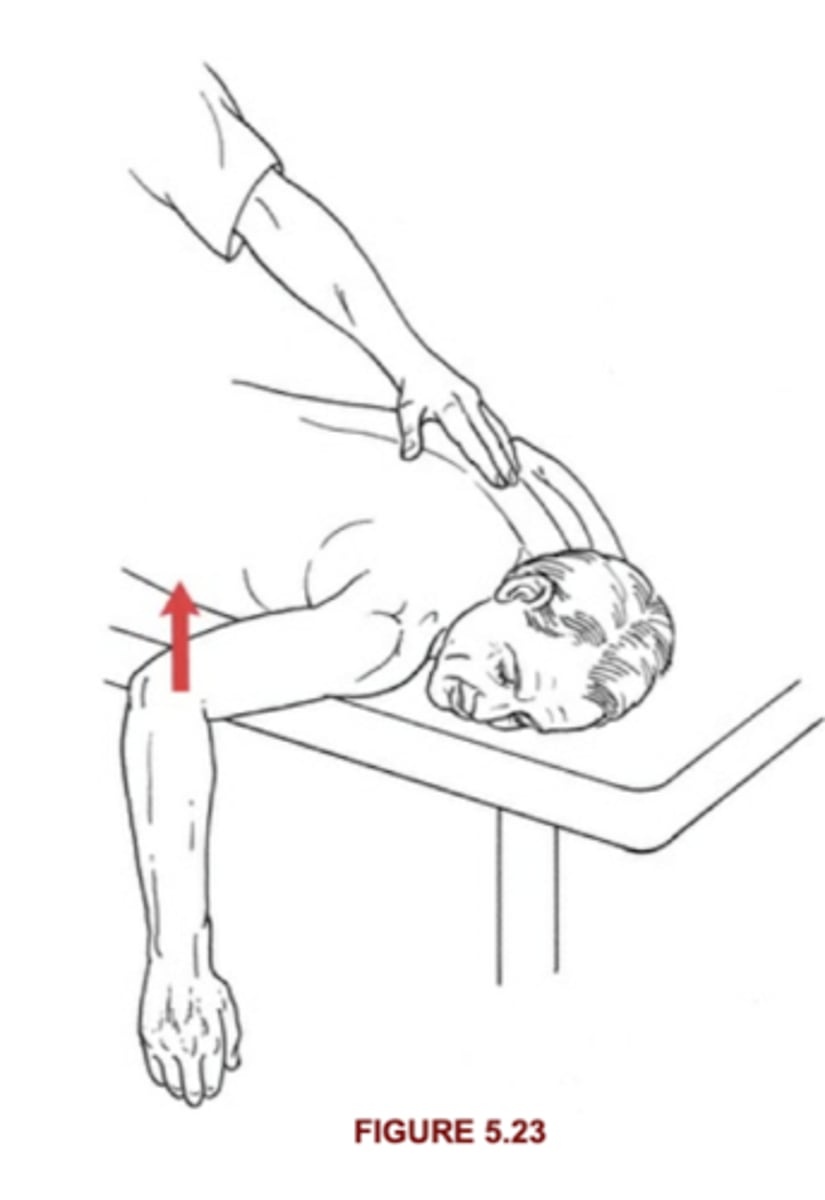
Scapular adduction (retraction) 5/5 + 4/5
5: Holds against max resistance
4: Holds against strong-moderate resistance
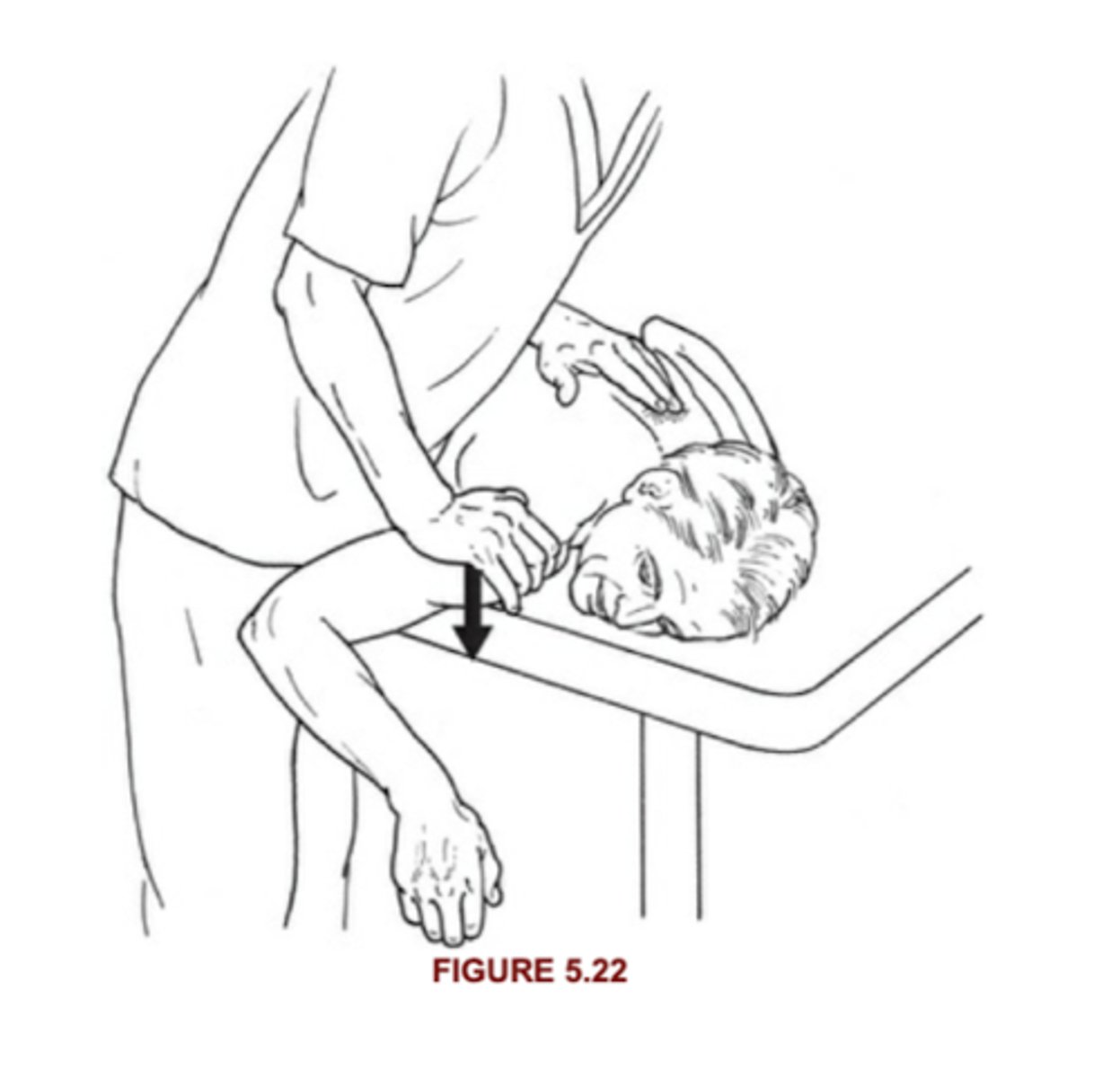
Scapular adduction (retraction) 2/5
PT cradles shoulder to support weight, uses other hand to palpate. 2/5 is FULL ROM
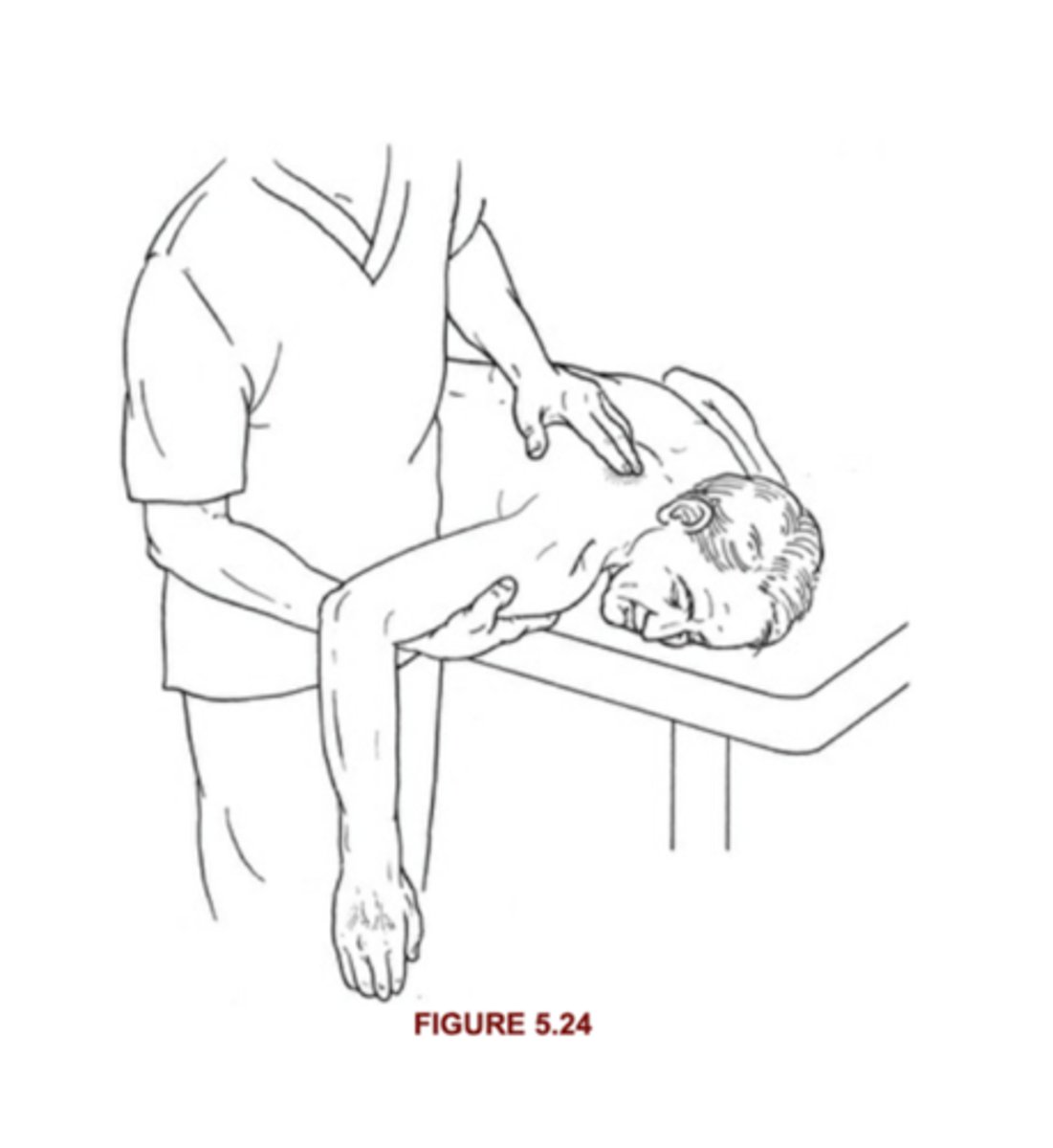
Scapular depression and adduction patient position
Prone, arm overhead in shoulder extension, ABD to 145, thumb up, head toward test side
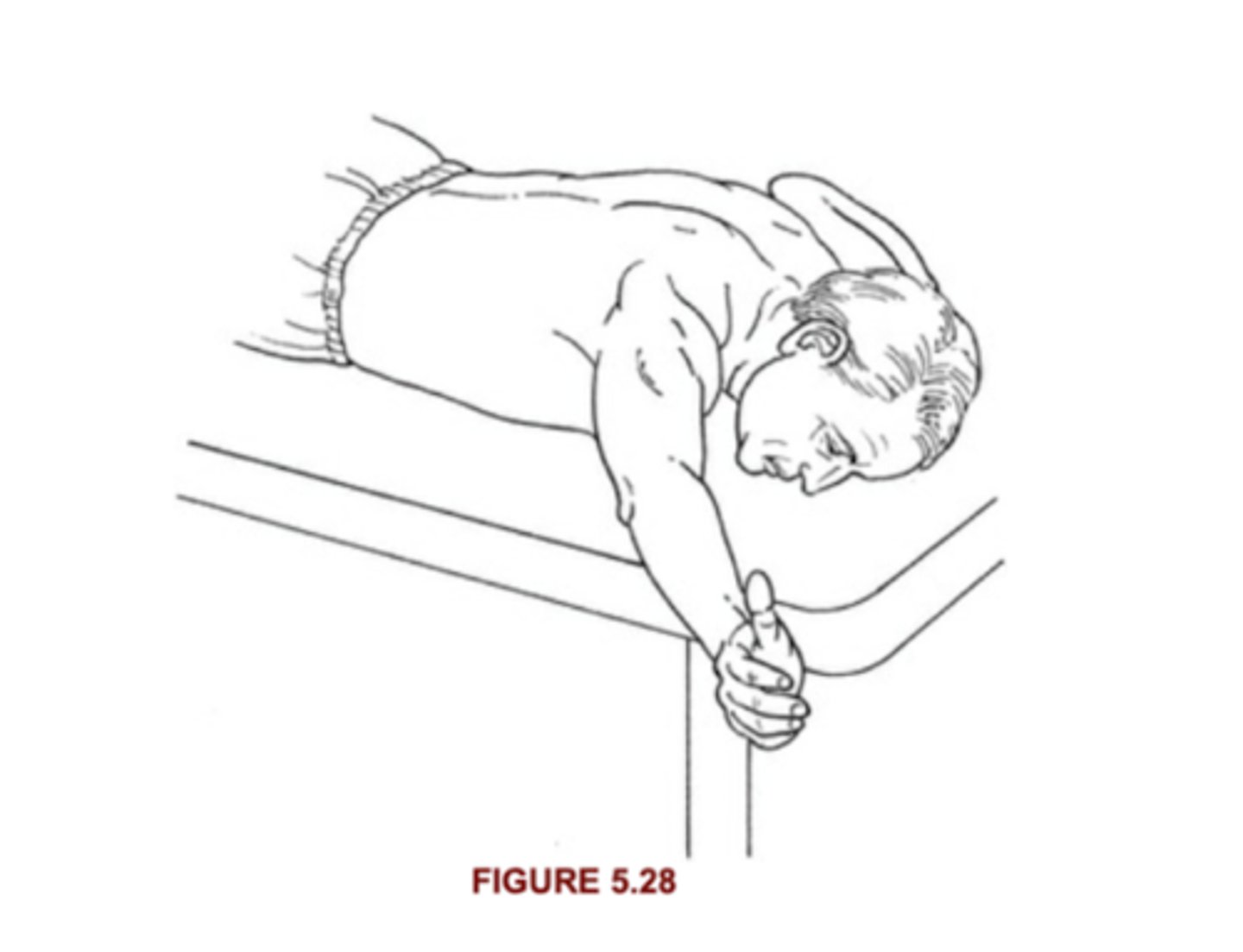
Scapular depression and adduction PT position
Resist at distal forearm just above the wrist, if they can't hold test position with resistnace, resist over distal humerus
Scapular depression and adduction muscles tested
Middle and lower traps
Scapular depression and adduction Fair Test 3/5
Arm raised from table against gravity, but cannot tolerate resistance
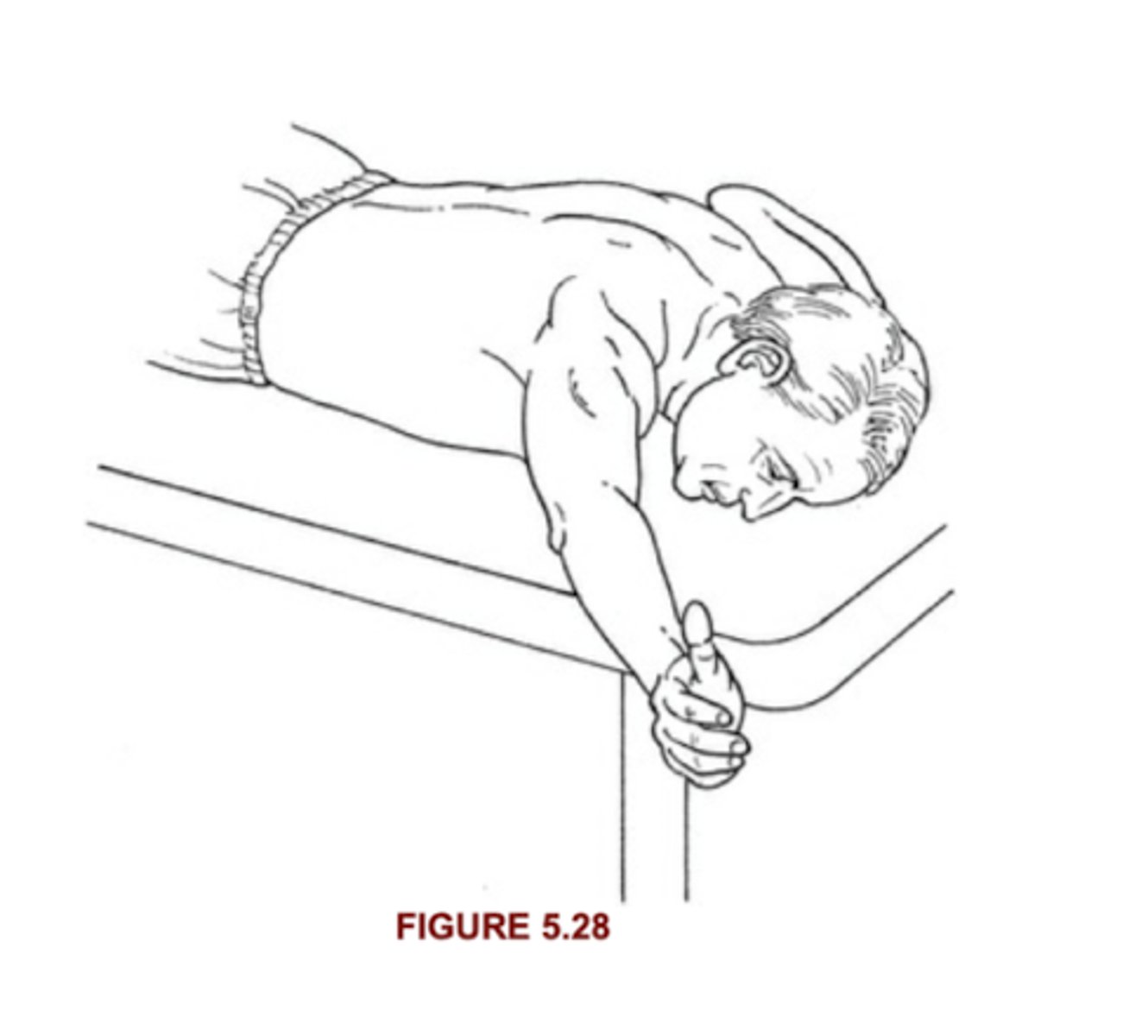
Scapular depression and adduction 5/5 + 4/5
5: holds against strong resistance at forearm
4: Holds against strong resistance at distal humerus or light at forearm
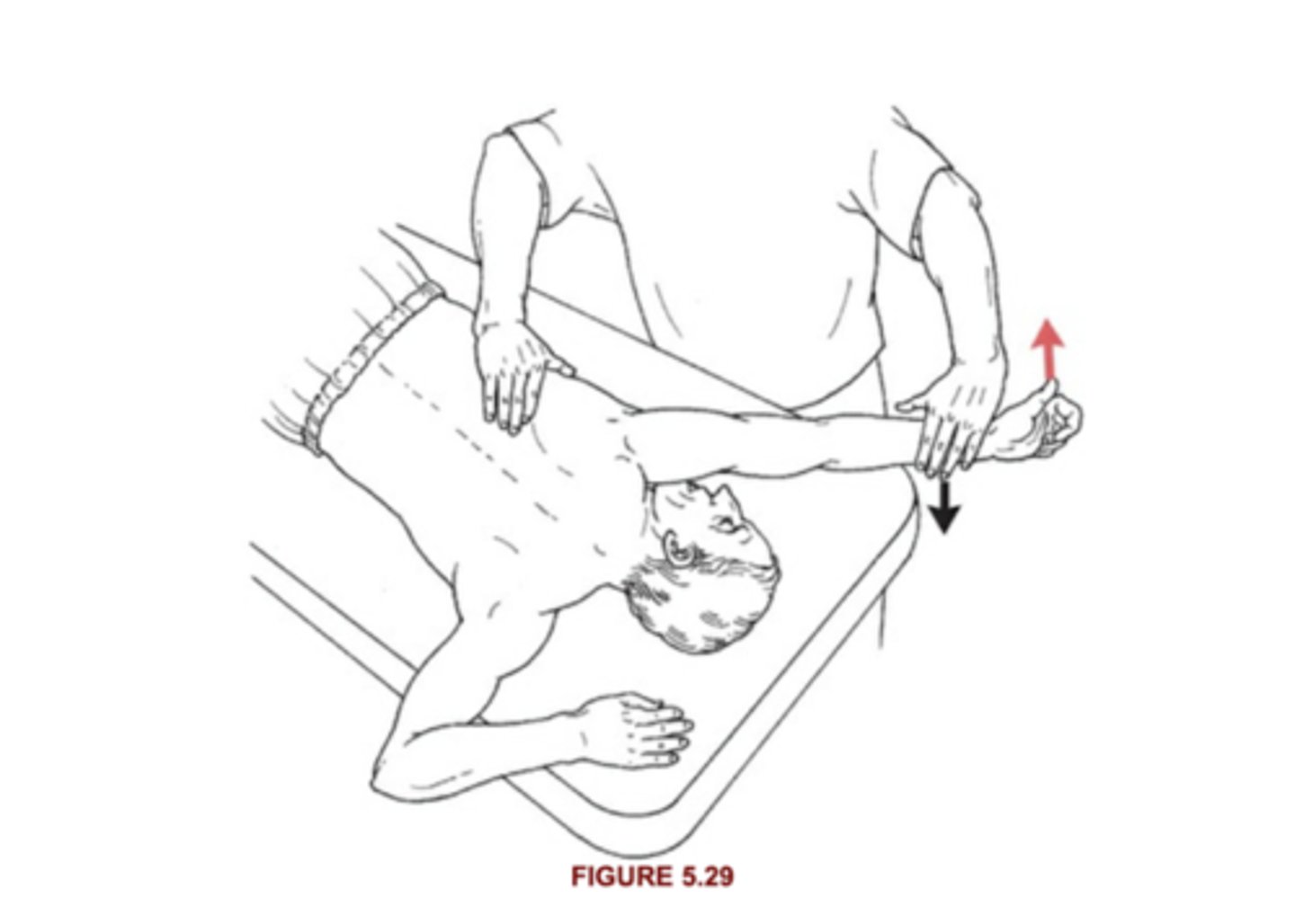
Scapular depression and adduction 2/5
Completes full ROM without weight of arm
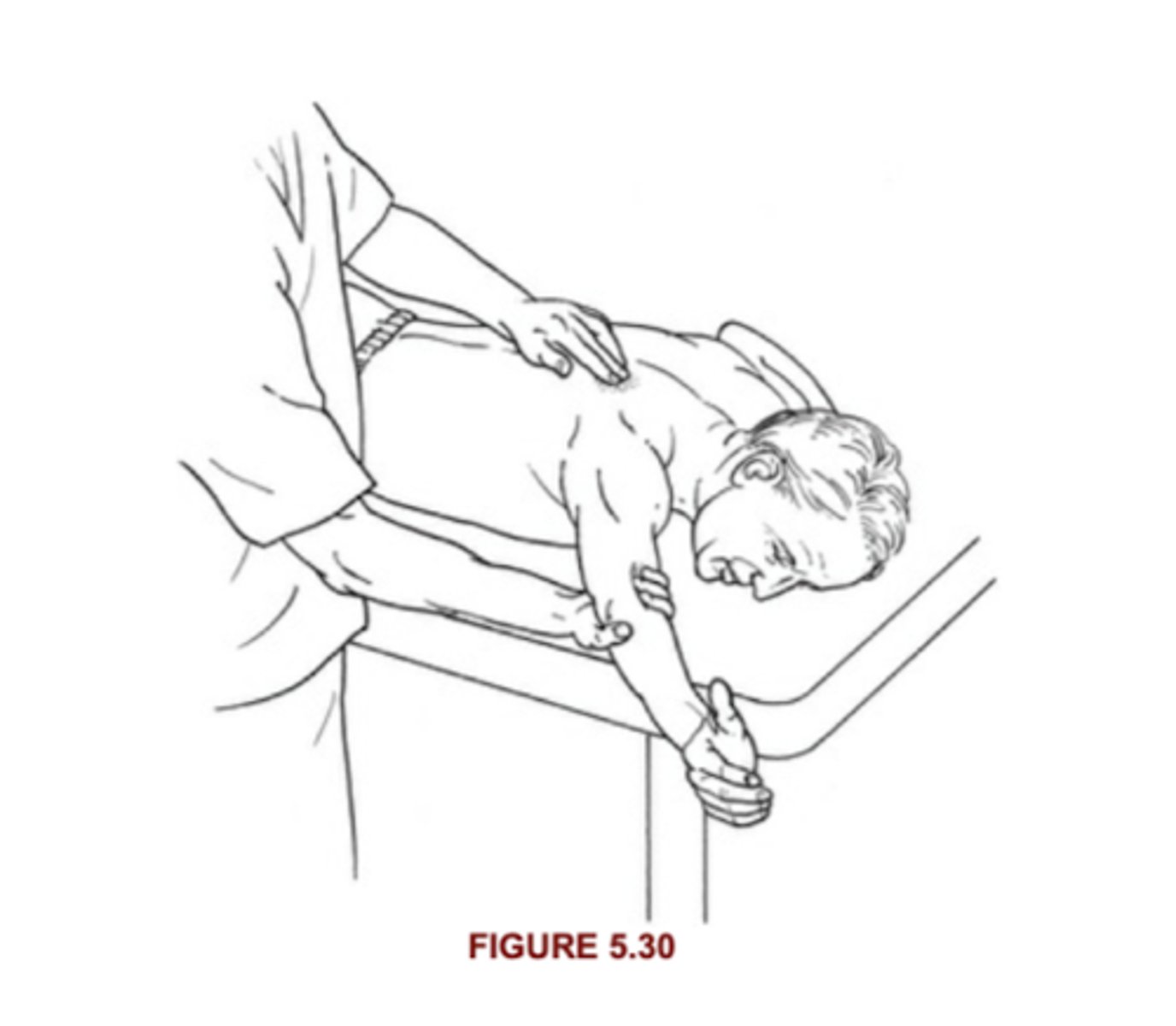
Scapular depression and adduction 1/5
Palpate lower trapezius (between root of scapular spine and TV7-TV12)
Scapular adduction with downward rotation patient position
Prone, shoulder IR, arm ADD across back, elbow flexed, hand resting on back
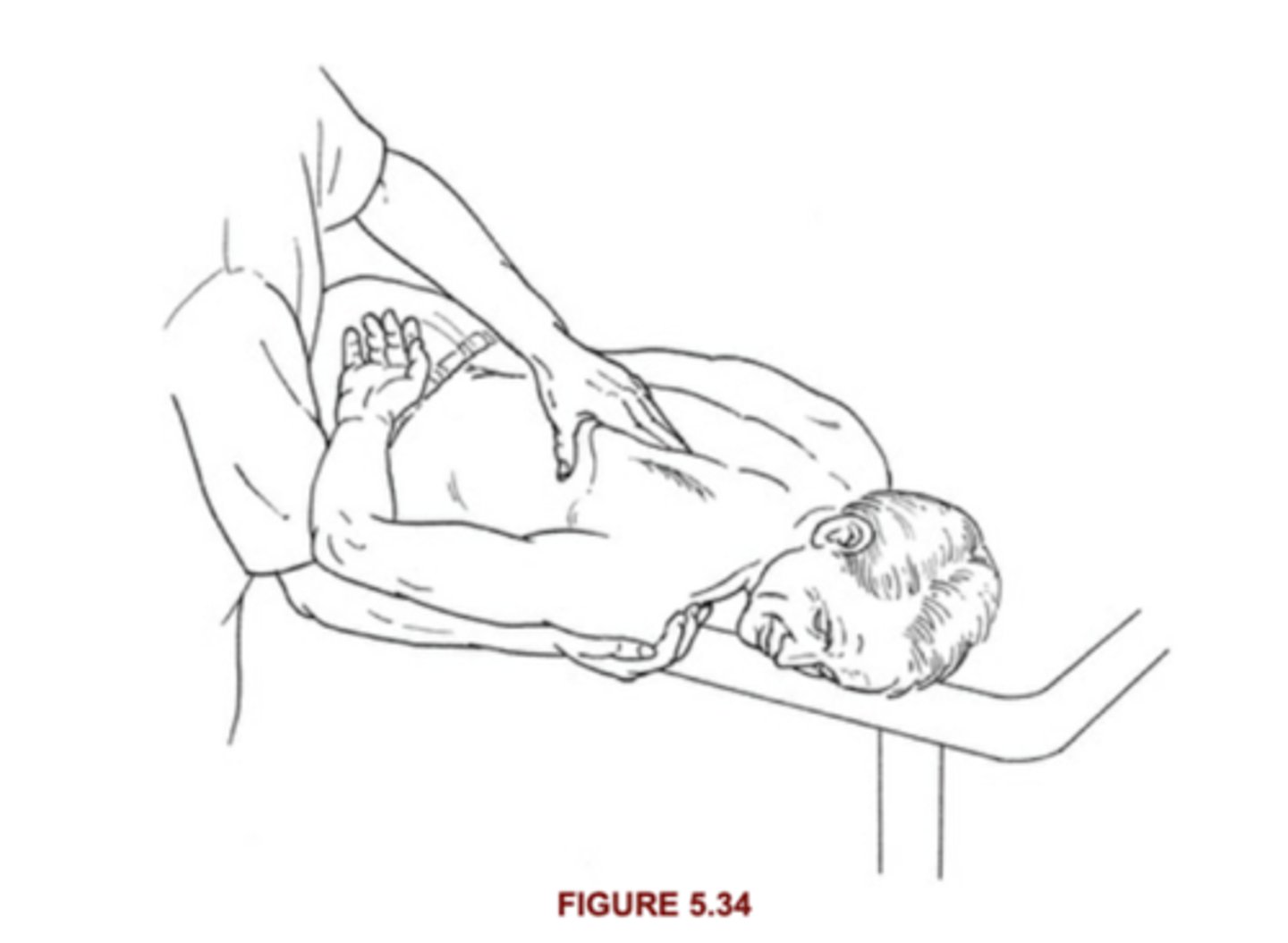
Scapular adduction with downward rotation PT position
Resist on humerus, just above elbow in outward and downward direction: other hand palpates under medial border of scapula
Scapular adduction with downward rotation muscles tested
Rhomboid major
Rhomboid minor
Scapular adduction with downward rotation Fair Test 3/5
Patient lifts hands off back through full ROM without resistance
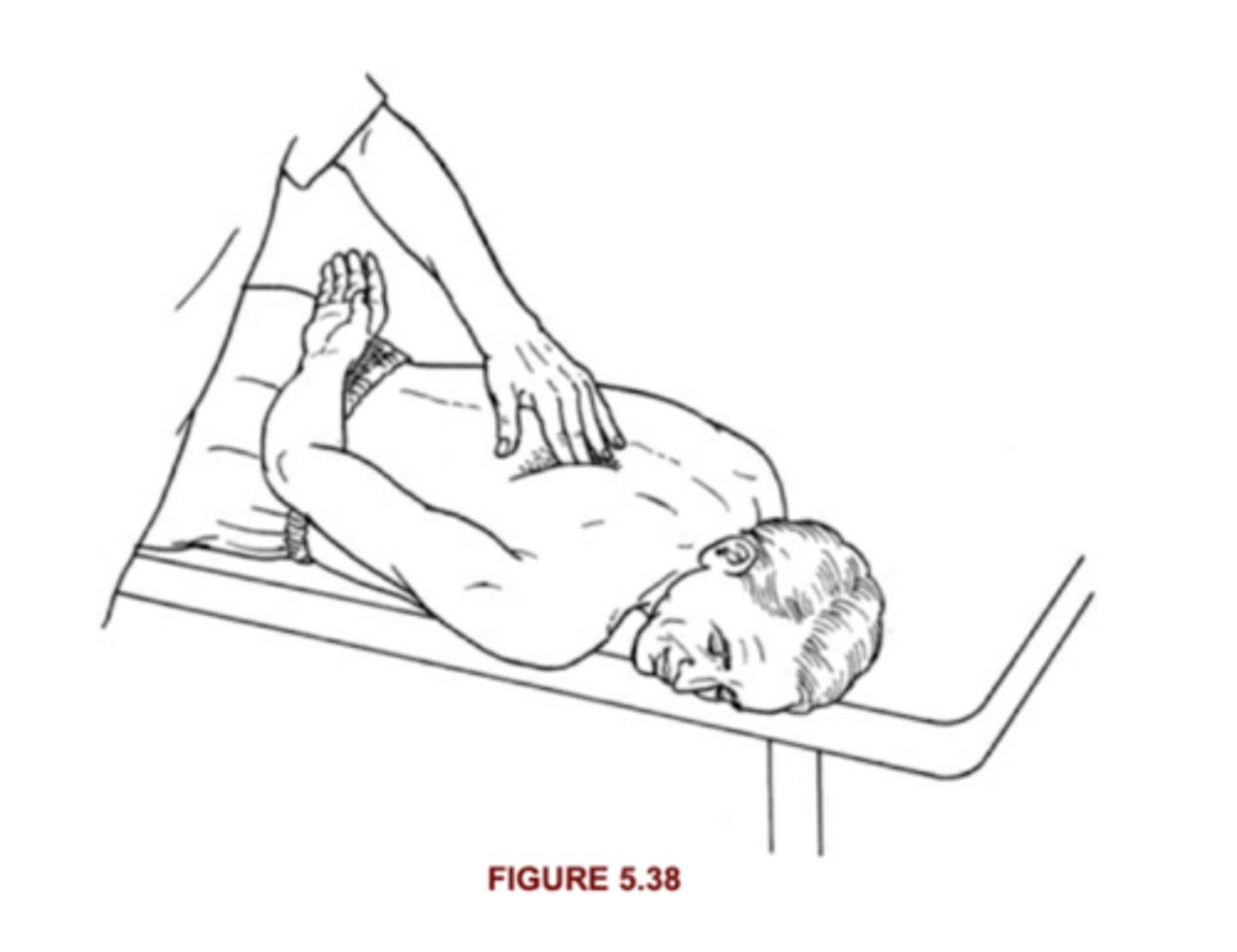
Scapular adduction with downward rotation 5/5 + 4/5
5: Holds against max resistance
4: Holds against strong to moderate resistance
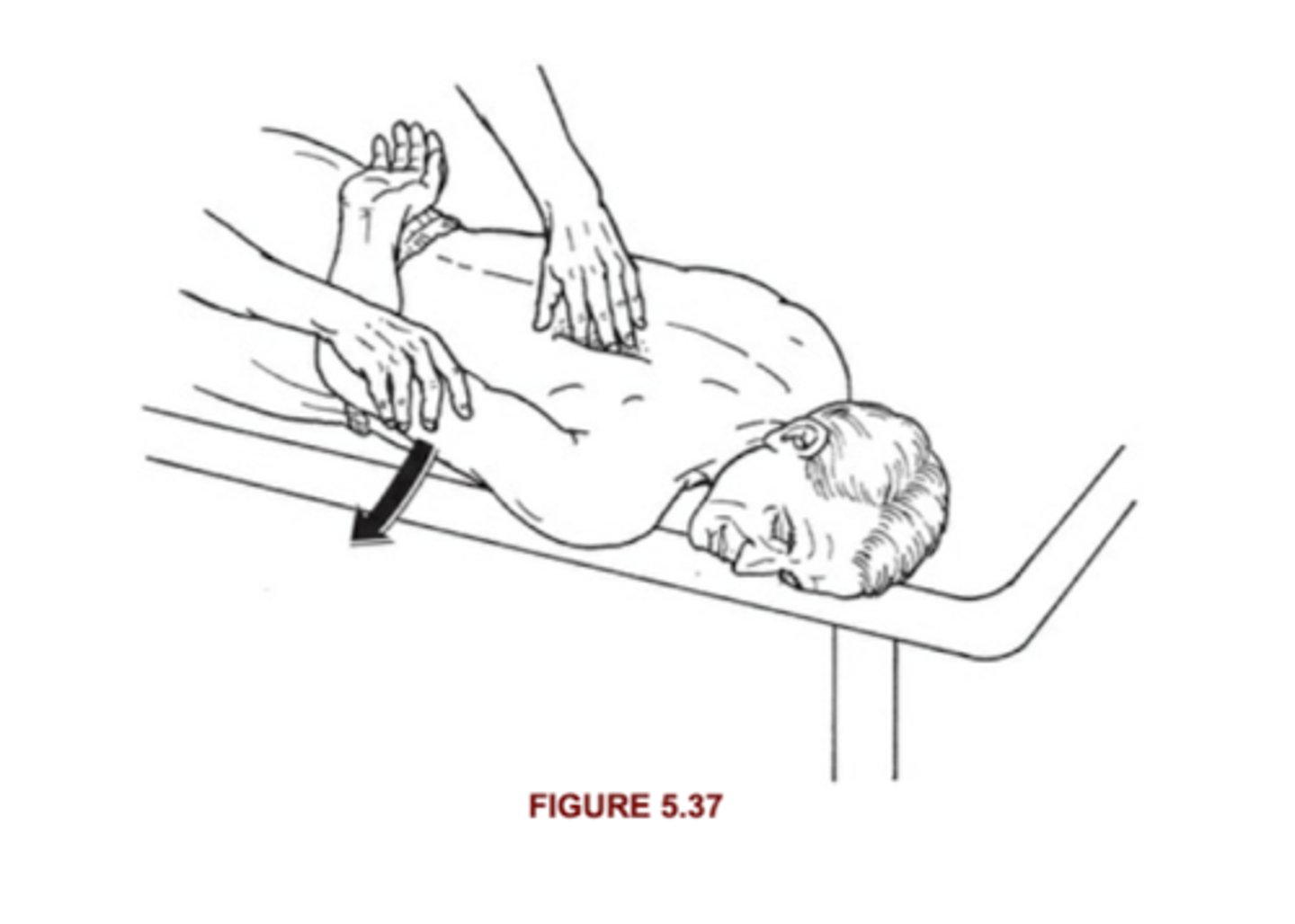
Scapular adduction with downward rotation 2/5
Seated, shoulder IR, EXT, and ADD behind back; arm supported at wrist; Completes FULL ROM
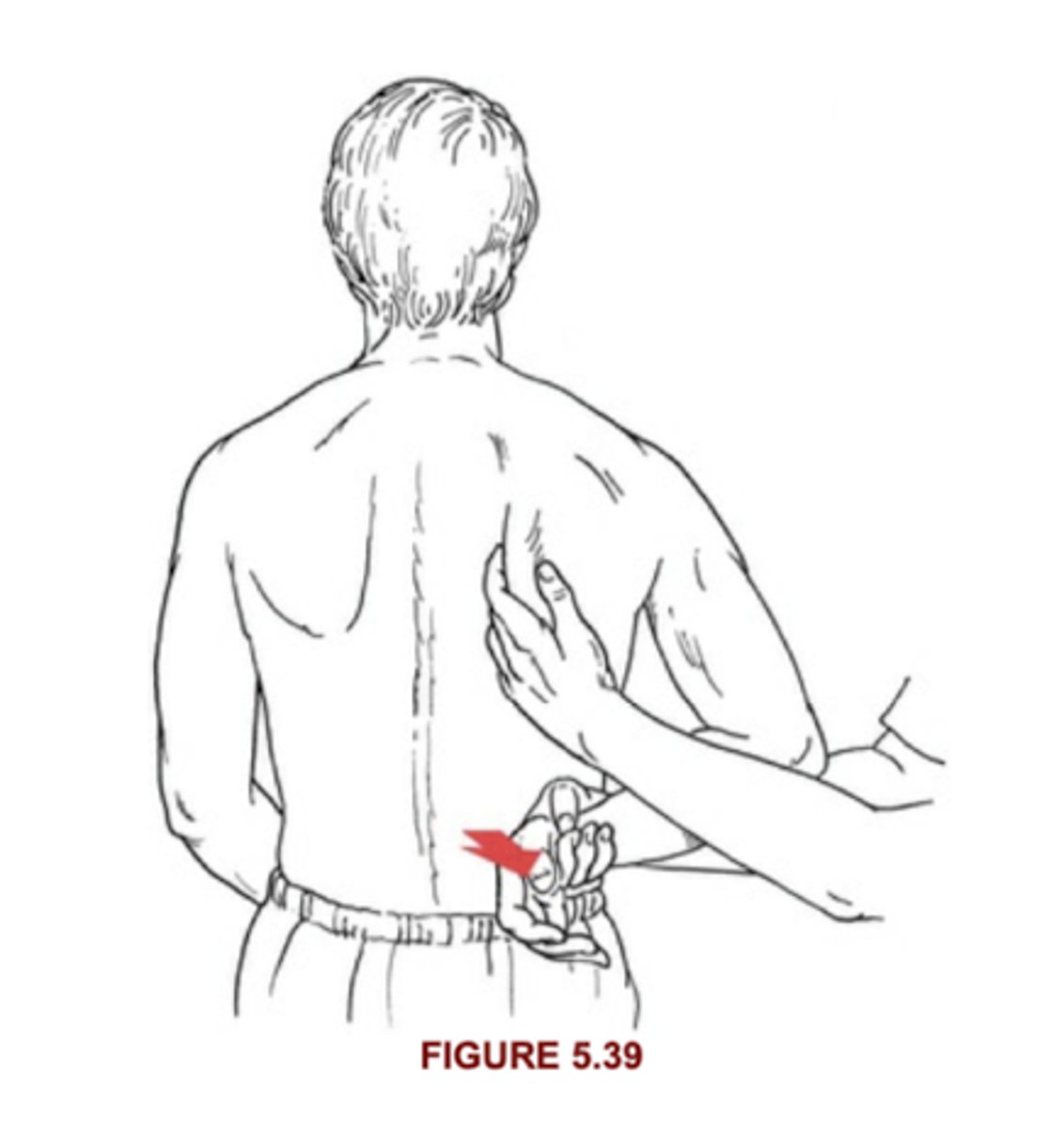
Scapular adduction with downward rotation 1/5
Palpate under medial border of scapula